Exhibition dates: 2nd May – 18th September 2022
Curators: The exhibition is curated by Emma Chambers (Curator, Modern British Art, Tate Britain), Caroline Corbeau-Parsons (Curator of Drawings / Conservatrice des Arts Graphiques at Musée d’Orsay) and former Curator, British Art, 1850-1915 at Tate Britain), the late Delphine Lévy (former Executive Director, Paris Musées) and Thomas Kennedy (Assistant Curator, Modern British Art, Tate Britain).
Walter Richard Sickert (British, 1860-1942)
The Red Shop (or The October Sun)
c. 1888
Oil on canvas
Norwich Castle Museum & Art Gallery, Norfolk Museums Service
I believe that Walter Sickert is an interesting and boundary pushing artist – but I remain ambivalent as to whether I like this attention seeking European modernist, this “self-proclaimed realist and literary painter with an interest in narrative” with his penchant for working-class urban culture and its “dank land of rented rooms, sickly streets and gaslit pubs,” its opium dens, street gangs and prostitutes, its black fogs and murders.
On the one hand I like the chthonic [relating to or inhabiting the underworld] darkness of his paintings, and their earthiness and essentialness, for Sickert is a chthonic deity [from Greek khthōn ‘earth’] grounded in the earth. His self-portraits appear as dark, almost eyeless creatures metastasizing from the Stygian gloom like a London pea souper fog – black fog, black dog examinations of the inner self interpreted as performances of identity. His paintings of the ghouls in the galleries at theatres are masterful in their use of colour, light and form – soaring to the heavens or buried like children in a mine, as in The Gallery at the Old Mogul (1906, below).
I am much less certain about other elements of his painting, such as the objectification of women in the numerous nudes, laid out for the viewers delectation. As Jonathan Jones observes,
“These are truly shocking images, more than a century on. Yet they have affinities with some of the greatest modern art, as the exhibition demonstrates. Sickert was strongly influenced by Degas, and in turn influenced Lucian Freud – there are nudes here by both for comparison.
The most appalling aspects of Sickert’s nudes are also their artistic strength. He rejects the phoney academic nude for raw naked reality – he even wrote an essay explaining this aesthetic. This is why he depicts women, more literally perhaps than any artist, as objects: because the body is an object, it is meat. Francis Bacon would agree with him.”1
Francis Bacon would of course agree with him, but there is an essential difference… Bacon was a male dissecting male bodies; in Sickert’s fantasy world of murder and voyeurism, it is the male gaze looking at a disempowered and dismembered female body and his paintings “are shot through with suppressed malevolence – a horrible aura of voyeurism, encroachment or outright violence.” While the nude paintings can be seen as essential and earthy challenging the conventional approach to life painting – “The modern flood of representations of vacuous images dignified by the name of ‘the nude’ represents an artistic and intellectual bankruptcy” – the energy which emanates from these paintings is perverse, like a butcher selling putrid meat which gives off a fecund but malodorous smell. According to Australian artist Elizabeth Gertsakis, there is a deep psychopathology present in Sickert’s work: “there are no ‘souls’ in Sickert’s art, nor is there redemption. There is despair, degeneracy and a kind biblical vengeance without the costume-play of the Testaments.”2
Finally, the late photo-based paintings from the late 1920s and 30s which would have astounded at the time of their creation, today feel frozen and stilted – the beginning of pastiche painting which lives on in the contemporary portraiture of Australia’s Archibald prize for example, where “we see the usual clumsily drawn figures; the usual ‘kooky’ whimsy; the usual ham-fisted, photo-based ‘realism’ (always the last bastion for the conceptually limited painter!). All of them dead in the water before they are even unwrapped for the scrutiny of the dull-eyed panel. Before they have even left the easel, in fact.”3 As Steve Cox observes, portrait ‘Painting’ become portrait ‘Illustration’ blossomed into its full-blown, grotesque, nadir.
Nevertheless, there are moments of sublime ecstasy in some of Sickert’s realist, narrative elegies: the red dress of Minnie Cunningham at the Old Bedford (1892, below); the “dynamic evocation of the local fair in Dieppe” with its background “enriched with acidic greens, lurid yellows and vivid scarlets” in The Fair at Night (c. 1902-1903, below); the gold decoration of the arch in The Horses of St Mark’s, Venice (c. 1901-1906, below); and the poignancy of the emaciated figure that is Aubrey Beardsley (1894, below), a haunting appearance suggested by the deftest and most skilful application of paint in search of a soul that you are ever likely to see.
Dr Marcus Bunyan
1/ Jonathan Jones. “Walter Sickert review – serial killer, fantasist or self-hater? This hellish, brilliant show only leaves questions,” on The Guardian website Tue 26 Apr 2022 [Online] Cited 15/05/2022
2/ Elizabeth Gertsakis in conversation with Marcus Bunyan 19/06/2022
3/ Steve Cox. “Thoughts on the Anti-Art Event, the Archibald Prize,” on Facebook May 7, 2022 [Online] Cited 18/06/2022
Many thankx to Tate Britain for allowing me to publish the media images in the posting. Please click on the photographs for a larger version of the image.
Discover the boundary-pushing paintings by one of Britain’s most influential artists
Walter Sickert is recognised as one of the most important artists of the 20th century, having helped shape modern British art as we know it. With ties to renowned painters from James Abbott McNeill Whistler to Edgar Degas, he strengthened the artistic connections between Britain and France and continues to influence contemporary painters to this very day.
The first major retrospective of Sickert at Tate in over 60 years, this exhibition explores how he had an often radical, distinctive approach to setting and subject matter. From working off detailed sketches to taking inspiration from news photography, these were the tools he used to depict his vision of everyday life.
A former actor, he had a flair and fascination for all things theatrical, including performers in music halls crafted on canvas, and nude portraits staged in intimate, domestic settings. His imagination was also fuelled by current events including the rise of celebrity culture, and he used this to create compelling narratives.
Much like the man, his art was complex. Creative and colourful, his body of work was ever-changing and can be interpreted in different ways. His own self-portraits, for example, showcase how he evolved throughout his career – from his beginnings as an actor and artistic apprentice, to becoming one of the most gifted and influential artists of his time.
This sense of a narrative runs against the grain of what has come to be construed as ‘modern’ in modern art. But Sickert insisted that ‘All the great draughtsmen tell a story’.16 He maintained that no country could have a great school of painting when the unfortunate artist was confined ‘to the choice between the noble site as displayed in the picture-postcard, or the quite nice young person, in what Henry James has called a wilderness of chintz’.17 He was a self-proclaimed realist and literary painter with an interest in narrative and an obsession with facture [i.e. the quality of the execution of a painting; an artist’s characteristic handling of the paint]. (He called it ‘the cooking side of painting’.18) He did not believe in severing subject and treatment:
“Is it not possible that this antithesis is meaningless, and that the two things are one, and that an idea does not exist apart from its exact expression? … The real subject of a picture or a drawing … and all the world of pathos, of poetry, of sentiment that it succeeds in conveying, is conveyed by means of the plastic facts expressed … If the subject of a picture could be stated in words there had been no need to paint it.”
It is in this sense – rather than in any quibbling as to the recorded details of Emily Dimmock’s murder in 1907 – that Sickert’s paintings are not illustrations. They cannot be decanted into words. And they do not use the available ‘language’ of illustration for sensational events, evident in the depictions of the Camden Town Murder in such publications as the Illustrated Police Budget and News.20 But their subject matters.
Walter Sickert, ‘The Language of Art’, New Age, 28 July 1910, quoted in Osbert Sitwell (ed.), A Free House! or The Artist as Craftsman: Being the Writings of Walter Richard Sickert, Macmillan, London 1947, p. 89 in Lisa Tickner. “Walter Sickert: The Camden Town Murder and Tabloid Crime,” on the Tate website Nd [Online] Cited 17/05/2022
Walter Richard Sickert (British, 1860-1942)
The Juvenile Lead (Self Portrait)
1907
Oil on canvas
Southampton City Art Gallery
Walter Richard Sickert (British, 1860-1942)
Self-portrait
c. 1896
Oil on canvas
Leeds Art Gallery
© Bridgeman images
Walter Richard Sickert (British, 1860-1942)
Self Portrait: The Bust of Tom Sayers
c. 1913-1915
Oil on canvas
The Ashmolean Museum, University of Oxford
Walter Sickert | Trailer | Tate
Installation view of the exhibition Walter Sickert at Tate Britain, May – September 2022 showing at left, Little Dot Hetherington at the Bedford Music Hall 1888-1889 below; at and right, The P.S. Wings in the O.P. Mirror c. 1888-1889 below
Walter Richard Sickert (British, 1860-1942)
Little Dot Hetherington at the Bedford Music Hall
1888-1889
Oil on canvas
Private collection
Photo: James Mann
Walter Richard Sickert (British, 1860-1942)
The P.S. Wings in the O.P. Mirror
c. 1888-1889
Oil on canvas
Rouen, Musée des Beaux-Arts
Installation view of the exhibition Walter Sickert at Tate Britain, May – September 2022 showing at left, Edgar Degas’ The Ballet Scene from Giacomo Meyerbeer’s opera “Robert le Diable” 1876, below; and at right, Little Dot Hetherington at the Bedford Music Hall 1888-1889 above
Edgar Degas (French, 1834-1917)
The Ballet Scene from Giacomo Meyerbeer’s opera “Robert le Diable”
1876
Height: 76.6cm (30.1 in)
Width: 81.3cm (32 in)
Victoria and Albert Museum
Public domain
Installation view of the exhibition Walter Sickert at Tate Britain, May – September 2022 showing at left, Gallery of the Old Bedford 1894-1895 below; at second left, Noctes Ambrosianae, Gallery of the Old Mogul 1906-1907 below; and at fourth left, The Gallery at the Old Mogul 1906 below
Walter Richard Sickert (British, 1860-1942)
Gallery of the Old Bedford
1894-1895
Oil on canvas
Purchased by the Walker Art Gallery in 1947
Walter Richard Sickert (British, 1860-1942)
Noctes Ambrosianae, Gallery of the Old Mogul
1906-1907
Oil on canvas
63.7 x 76.6cm
Birmingham Museums Trust
Purchased 1949
Walter Richard Sickert (British, 1860-1942)
The Gallery at the Old Mogul
1906
Oil on canvas
63.5 x 67cm
Walter Sickert’s The Gallery at the Old Mogul is thought to be one of the earliest paintings in the world of a cinematic performance. Early press descriptions prove that the original title of the picture was Cinematograph and shows a film screening of a Western.
Before the existence of purpose built cinemas, films were often shown in music halls as part of the evening’s entertainment. ‘The Old Mogul’ was the original name for the Middlesex Music Hall in Drury Lane, remodelled and renamed in the 1870s, and variously known as ‘the Mogul Tavern’, ‘the Old Mo’, and ‘the Old Middlesex’. The present work was painted soon after Sickert’s return to London in 1906, at a time when Sickert was rediscovering his fascination for music-hall subjects. ‘I have started many beautiful music-hall pictures. I go to the Mogul Tavern every night, Sickert wrote to Jacques-Émile Blanche in 1906. Related works of the same subject include Noctes Ambrosianae painted in the same year and four related drawings in the Walker Art Gallery Liverpool and Aberdeen Art Gallery. …
Sickert’s inspiration for depicting new forms of entertainment such as cinema performances stemmed partly from French artists, including Degas’ depictions of Parisian Café Concerts and theatres. Sickert, however, was one of the first artists to examine scenes of popular entertainment in a British art context. Unlike Degas, the focus is less on the performance – or in this case screening – and more on the relationship of the audience to the show. This method was developed in Sickert’s earliest entertainment works such as the Old Bedford Gallery pictures of the 1890s [above], which like the present work choose to focus on the audience from behind, inviting the viewer to feel at once a part of the spectacle and yet distant from the subjects. This tool was partly borrowed by Sickert from French Impressionist works such as Manet’s Un bar aux Folies Bergère, where the viewer is made to feel like they are ordering a drink at a bar but is unable to witness the full transaction. Sickert’s ability to create this ambiguity allows the onlooker to invent narratives for the scene, and is one of the reasons he remarked to Virginia Woolf, ‘I have always been a literary painter’ (V. Woolf, Walter Sickert: A Conversation, London, 1934, p. 26). While Sickert’s work may not have the sentiment or caricature of Charles Dickens’ (as loosely suggested by Woolf in 1934), it often manages to give the impression that you are viewing a moment in time, a snapshot that leaves one guessing as to what has just happened or what will happen next.
It is of no surprise therefore, that in later years Sickert began increasingly to adapt compositions directly from photographs. Yet unlike a photograph, The Gallery at the Old Mogul seems full of movement. Sickert maintains the ability not to simply depict but to create dramatic atmosphere through low tones and a liquid handling of paint reminiscent of Whistler and indeed of a cinematic performance. The Gallery at the Old Mogul successfully predicted not only the importance of film on everyday cultural life but on many subsequent art movements such as the Cubist works of Braque and Picasso between 1907-1914.
Jon Fauer. “First painting of a Movie Theater: Sickert’s “The Gallery at the Old Mogul”,” on the Film and Digital Times website 16/06/2016 [Online] Cited 15/05/2022
Walter Richard Sickert (British, 1860-1942)
The Pit at the Old Bedford
1889
Oil on canvas
34.5 x 30.0cm
Fondation Bemberg
Walter Richard Sickert (British, 1860-1942)
Vesta Victoria at the Old Bedford
c. 1890
Oil on panel
14 1/2 x 9 1/4 ins (37 x 23.5cms)
Private collection, UK
Walter Richard Sickert (British, 1860-1942)
Gaîté Montparnasse
c. 1907
Oil paint on canvas
612 × 508 mm
The Museum of Modern Art, New York
Mr. and Mrs. Allan D. Emil Fund, 1958
Installation view of the exhibition Walter Sickert at Tate Britain, May – September 2022 showing at left, Minnie Cunningham at the Old Bedford 1892 below; and at right, Brighton Pierrots 1915 below
Walter Richard Sickert (British, 1860-1942)
Minnie Cunningham at the Old Bedford
1892
Oil paint on canvas
Support: 765 × 638 mm
Frame: 915 × 787 × 69 mm
Tate
Purchased 1976
Minnie Cunningham was a popular performer at the Old Bedford Music Hall in Camden Town. Sickert went there regularly and made dozens of sketches capturing the effects of light and movement on the stage and in the auditorium. Here, Sickert paints from the point of view of an audience member. He first exhibited it with the subtitle ‘I’m an old hand at love, though I’m young in years’, a quote from one of Cunningham’s songs. Sickert painted the ordinary life he saw around him.
Gallery label, September 2020
Walter Richard Sickert (British, 1860-1942)
Brighton Pierrots
1915
Oil on canvas
Tate
Purchased with assistance from the Art Fund and the Friends of the Tate Gallery 1996
This week, Tate Britain opened London’s biggest retrospective of Walter Sickert (1860-1942) in almost 30 years. A master of self-invention and theatricality, Sickert took a radically modern approach to painting in the late 19th and early 20th centuries, transforming how everyday life was captured on canvas. This major exhibition features over 150 of his works from over 70 public and private collections, from scenes of rowdy music halls to ground-breaking nudes and narrative subjects. Spanning Sickert’s six-decade career, it uncovers the people, places and subjects that inspired him and explores his legacy as one of Britain’s most distinctive, provocative, and influential artists.
Highlights include 10 of Sickert’s iconic self-portraits, from the start of his career to his final years. For the first time, these portraits are brought together from collections across the UK and internationally, including the National Portrait Gallery in London, the Ashmolean Museum in Oxford, and the Art Gallery of Hamilton in Canada. The variety of different personas adopted by Sickert over the years are shown together – a legacy of his early life as an actor – and how his complex personality evolved on the canvas throughout his career.
Sickert’s interest in the stage is also reflected in one of his favourite artistic subjects: the music hall. His dramatic images of performers and audiences, often captured together from unusual and spectacular angles, evoked the energy of working-class city nightlife. The exhibition examines Sickert’s British and French music hall subjects together through over 30 atmospheric paintings and drawings of halls in London and Paris, including The Old Bedford 1894-1895, Gaité Montparnasse 1907 and Théâtre de Montmartre c. 1906 as well as depictions of famous performers such as Minnie Cunningham and Little Dot Hetherington. Although these subjects were deemed inappropriate by much of the British art world at the time, they took inspiration from the café-concert subjects of celebrated French artists such as Edouard Manet and the ballet subjects of Edgar Degas, a close friend and major influence on Sickert after they met in Paris in the 1880s.
The exhibition is the first to explore the impact of another of Sickert’s key influences, from his time as an assistant in the studio of renowned American artist James Abbott McNeill Whistler. Paintings by both artists, including Whistler’s A Shop 1884-1890 and Sickert’s A Shop in Dieppe 1886-1888 have been brought together, as well as Whistler’s 1895 portrait of Sickert himself, to reveal how the young artist was inspired by his mentor’s atmospheric tonal style and urban subjects. The show examines how Sickert went on to create series of works that experimented with how changing light transformed the facades of famous buildings in some of his favourite cities, including Dieppe and Venice.
Sickert revolutionised the traditional genres of painting in ways that changed the course of British art. His nudes were admired in France but disapproved of in Britain, where they were considered immoral because of their unidealised bodies, contemporary settings and voyeuristic framings. They drew on the influence of artists such as Bonnard and Degas and paved the way for later painters like Lucian Freud. The Camden Town Murder series further transformed Sickert’s nude subjects into narrative paintings by juxtaposing two figures in a claustrophobic interior, while his other domestic scenes such as Ennui 1914 and Off To the Pub 1911 continued this exploration of conflicted emotions and complex modern relationships.
In his final years, his work took on a new and ground-breaking form in larger, brighter paintings based on news photographs and popular culture, including images of Amelia Earhart’s solo flight across the Atlantic and Peggy Ashcroft in a production Romeo and Juliet. This pioneering approach to photography was an important precursor to Francis Bacon’s use of source material and to pop art’s transformation of images from the media, once again revealing Sickert’s role at the forefront of developments in British art.
Walter Sickert is organised by Tate Britain in collaboration with the Petit Palais, Paris. The exhibition is curated by Emma Chambers (Curator, Modern British Art, Tate Britain), Caroline Corbeau-Parsons (Curator of Drawings / Conservatrice des Arts Graphiques at Musée d’Orsay) and former Curator, British Art, 1850-1915 at Tate Britain), the late Delphine Lévy (former Executive Director, Paris Musées) and Thomas Kennedy (Assistant Curator, Modern British Art, Tate Britain). It is accompanied by a fully illustrated catalogue from Tate Publishing.
Press release from Tate Britain
Installation views of the exhibition Walter Sickert at Tate Britain, May – September 2022 showing at centre in the bottom photograph, The Mantelpiece c. 1906-1907 below; and at right, Girl at a Window, Little Rachel 1907 below
Walter Richard Sickert (British, 1860-1942)
The Mantelpiece
c. 1906-1907
Oil paint on canvas
762 x 508 mm
Southampton City Art Gallery
© Estate of Walter R. Sickert / DACS
Photo © Southampton City Art Gallery, Hampshire, UK / The Bridgeman Art Library
The art historian Wendy Baron has identified the theme of the mantelpiece still life as an offshoot of Walter Sickert’s paintings of interiors with figures, although Sands may also have been aware of Edouard Vuillard’s painting, The Mantelpiece (La Cheminée) 1905 (fig.1). Large decorative fire surrounds in marble or wood became fashionable during the Victorian period, emphasising the open fire as the focus of a room with its symbolic notions of the domestic hearth and home. By the early twentieth century these mantelpieces, usually surmounted by a large overmantel mirror and a shelf broad enough to accommodate an array of ornaments, were a standard feature in most homes, as can be seen in the dingy and claustrophobic interior of Sickert’s famous painting, Ennui c. 1914 (Tate N03846). They were a feature instantly recognisable as characteristic of their time and appear in a number of paintings of Camden Town interiors by Sickert and his circle such as The Mantelpiece c. 1906-1907 (fig.2) by Sickert, and Spencer Gore’s Conversation Piece and Self-Portrait c. 1910 (private collection). Artists developing a more self-consciously abstract style used the mantelpiece and the inevitable shelf of clutter as a subject, even in Duncan Grant’s and Vanessa Bell’s paintings of the same mantelpiece in Bell’s house at 46 Gordon Square, The Mantelpiece 1914 (Tate T01328, fig.3) and Still Life on Corner of a Mantelpiece 1914 (Tate T01133, fig.4), where, however, it holds a piece of hand-made Bloomsbury decoration.
Nicola Moorby. “Ethel Sands: Flowers in a Jug ?1920s,” on the Tate website The Camden Town Group in Context July 2003 [Online] Cited 09/05/2022
Walter Richard Sickert (British, 1860-1942)
Girl at a Window, Little Rachel
1907
Oil paint on canvas
Support: 508 × 406 mm
Frame: 765 × 665 × 75 mm
Tate
This is one of six paintings and numerous drawings of Sickert’s frame-maker’s 13-year-old daughter, known affectionately as ‘Little Rachel’. Sickert described the series as a ‘set of studies of Illumination’. The scene outside the window is Mornington Crescent Gardens, Camden. The girl’s gaze is turned away from both the artist and the view. The closed window may suggest the future that was expected of her at the time, a future inside the home, as a wife and mother.
Gallery label, October 2020
This painting is dominated by the French window of Sickert’s north-facing front room at 6 Mornington Crescent. Light falls softly on the dim figure of the red-haired girl, seen looking across Mornington Crescent Gardens. Rachel, the daughter of his frame maker, features in five known oil paintings by Sickert.
There are five other known oils of the same sitter: Girl at a Looking-Glass, Little Rachel (fig.1);3 Little Rachel (National Art Gallery of Queensland, Brisbane),4 a head and shoulders portrait, probably seated on Sickert’s bed; Little Rachel (private collection),5 a three-quarter-length portrait of the sitter half turned, with light falling on her face; and Little Rachel (Plymouth City Museum and Art Gallery),6 an oil study in profile. In all these works she wears the same blouse as in Tate’s picture. There are several drawings of Rachel, some of which relate to these paintings, but none of them is a study for Tate’s oil.7
According to Sickert’s title for one of these oils and one of the drawings, the sitter was the daughter of his frame maker. Using information supplied by Agnew’s, the art historian Wendy Baron records that Rachel’s surname was Siderman, and that she died in 1963 aged 70. …
In Girl at a Window, Little Rachel, Sickert shows his sitter standing by the French windows of his north-facing, first-floor front room at 6 Mornington Crescent, London NW1, which he kept in 1907, just a few doors away from his friend Spencer Gore who lived at number 31. The room was rented, as Sickert wrote in a letter of 1907 to Nan Hudson addressed from Mornington Crescent, ‘I rather hope that when I come back in the autumn I may take the floor above my lodgings here as a room-studio and do the interiors I love’.11 The 1907 Kelly’s Camden and Kentish Town Directory lists the householder as ‘Mrs George Jones Jr’, who was presumably Sickert’s landlady. Mornington Crescent was only one of Sickert’s addresses, and at this time he also had another studio in Fitzroy Street. Following his return to London in 1905 Sickert had continued the practice he followed in Dieppe of keeping several studios at once, which probably sometimes doubled as living accommodation. The art critic Clive Bell recalled Sickert at a somewhat later period ‘showing us his “studios” – “my drawing studio” “my etching studio” etc. The operation involved chartering a cab and visiting a series of small rooms in different parts of London.’
Robert Upstone. “Walter Richard Sickert: Girl at a Window, Little Rachel 1907,” on the Tate website The Camden Town Group in Context May 2009 [Online] Cited 18/06/2022
Installation view of the exhibition Walter Sickert at Tate Britain, May – September 2022 showing at left, Nude Stretching: La Coiffure 1905-1906 below; and at centre, Reclining Nude – Le Lit de Cuivre about 1906 below
Walter Richard Sickert (British, 1860-1942)
Nude Stretching: La Coiffure
1905-1906
Pastel
71 x 55cm
Walter Richard Sickert (British, 1860-1942)
Reclining Nude – Le Lit de Cuivre
About 1906
Oil on canvas
644 x 541 mm
Royal Albert Memorial Museum and Art Gallery, Exeter City Council
Female nude reclining on a bed which has brass bedsteads. Le Lit de Cuivre translates to ‘copper bed’. There are several versions of this painting in existence. Sickert had begun to draw nudes on metal bedsteads in Dieppe in 1902 and on his return from Venice in 1904 he began to paint the subject. He continued to do so in London often working from drawings made in France eg. “Le Lit de Fer”. In many of his post-Venetian paintings of the nude, Sickert broke away from a horizontal planar emphasis by placing the bed in a diagonal recession or even at right angles to the surface. This work shows how Sickert had begun to develop a broken, crusty touch in the paint work.
Text from the Google Arts and Culture website
Walter Richard Sickert (British, 1860-1942)
Jack the Ripper’s Bedroom
1906-1907
Oil on canvas
50.8 x 40.7cm
Manchester Art Gallery
Bequeathed by Mrs Mary Cicely Tatlock, 1980
Dark, shadowy view of a bedroom seen through an open doorway. A wooden chair is in the foreground, in what is probably the hallway, to the left of the open door. A dressing table and chair are just distinguishable beneath the filtered pink half-light coming through the horizontal slats of the blind that covers the window at the back of the room. The items of furniture are so indistinct as to make it conceivable that there is a person sitting on the chair, although there is no one there. The bedroom is that of Sickert’s own lodgings at 6 Mornington Crescent. His landlady had told Sickert that she suspected the previous tenant might have been Jack the Ripper, the famous murderer.
Installation view of the exhibition Walter Sickert at Tate Britain, May – September 2022 showing at left, Nude Stretching: La Coiffure 1905-1906 above; and at second left, Reclining Nude – Le Lit de Cuivre about 1906 above
Installation view of the exhibition Walter Sickert at Tate Britain, May – September 2022 showing at second left, Jack Ashore 1912-1913 below; at second right, The Iron Bedstead c. 1908 below; and at right, Mornington Crescent Nude c. 1907 below
Walter Richard Sickert (British, 1860-1942)
Jack Ashore
1912-1913
Oil paint on canvas
Object: 368 × 298 mm
Frame: 568 × 494 × 92 mm
Pallant House Gallery, Chichester
Wilson Gift through the Art Fund 2006
Walter Richard Sickert (British, 1860-1942)
The Iron Bedstead
c. 1908
Oil on canvas
39.5 x 50cm
Earl and Countess of Harewood
Walter Richard Sickert (British, 1860-1942)
Mornington Crescent Nude
c. 1907
Oil on canvas
45.7 x 50.8cm
The Fitzwilliam Museum
Gift from Mrs Maurice Hill
Walter Richard Sickert (British, 1860-1942)
The Camden Town Murder, or, What Shall We Do for the Rent
c. 1908
Oil on canvas
Yale Center for British Art
But the question is what Sickert is staging in his own theatre, that dank land of rented rooms, sickly streets and gaslit pubs where men and women are at stalemate. The aesthetic origins are clear enough. Sickert – half Danish, student of Whistler, friend of Degas, admirer of Bonnard – continually aspires to European modernism. The debts are everywhere visible in the show. The most famous painting here, Ennui, pays direct homage to Degas’s drinkers stalled over their absinthe in Paris cafes with more than just its French title.
Five feet high, it is an immense snapshot of suicidal boredom. The glassy-eyed man lolls over his half-empty pint at the table; the woman leans on the chest of drawers, staring straight at the imprisoning walls. Next to her is a case of stuffed birds, trapped in a bell jar of their own. “It is all over with them,” wrote Virginia Woolf, imagining that innumerable dull days had crushed them like “an avalanche of rubbish.”
But the scene is conspicuously staged (to be reprised four more times), and eagle-eyed visitors will recognise the same models in other paintings. Hubby, as he was called, seems to have been an acquaintance of Sickert who had fallen on hard times; Marie was his cleaning lady. He has these working people pose again and again.
Hubby is just edging out of the scene on the way to the pub, just arriving, or terminally slumped. He reappears, with his sleeves menacingly rolled, over a naked woman on a bed in one of the so-called Camden Town nudes. Tate Britain has not shied away from showing a whole gallery of these paintings, which are shot through with suppressed malevolence – a horrible aura of voyeurism, encroachment or outright violence.
The relationship between the prone and naked woman and the clothed man, seated or standing, is disturbing enough. But in at least one painting, the notorious L’Affaire de Camden Town [below], the female body looks beaten like a heap of purpling meat in the gloom, and she is either shielding herself from the man above her, or she is already dead.
Sickert so often fudged (or simply fumbled) human anatomy that the question is how hard he worked to achieve this dark ambiguity. The title of this particular work refers to the murder of a woman named Emily Dimmock in Camden Town in 1907. Sickert’s paintings are a queasy conflation of crime scene, studio setup and social history, and he liked to confuse things further with deflecting titles. One picture is called What Shall We Do for the Rent? [above]
Laura Cumming. “Walter Sickert review – a master of menace,” on The Guardian website Sun 1 May 2022 [Online] Cited 12/05/2022
And the centre of this exhibition is a no-holds-barred display of Sickert’s nudes. Against the dark walls of the gallery, in fierce yet subtle lighting, the women are laid out. Their bodies are spread, exhibited, arranged, “like a patient etherised upon a table”, to quote TS Eliot. One model lies with her legs hanging over the bed, her arms spread out. She could be the dead Christ. Another is washing, but as she bends in a doorway we can’t see her head, only her naked body.
L’Affaire de Camden Town [below] takes it to another level. In this 1909 painting, a man stands over an inert female form on a bed. But it is worse than that. She is not so much a continuous figure as a collection of ruddy, moist forms like meat in a butcher’s window. The male onlooker could be a killer contemplating his handiwork – which is exactly what Sickert’s title implies. For this is one of a series of paintings that allude to the murder of Emily Elizabeth Dimmock in Camden, London, in 1907. Sickert became fascinated by this murder. If he really is responsible for sketches of a man with a knife over a woman’s body in the Ripper letters of 1888, his Camden Town Murder paintings eerily echo them.
In The Camden Town Murder, or What Shall We Do for the Rent?, [above] the man sits in despair while the nude on the iron bed has her face turned from us. She may be crying or he may have just throttled her. The stiffness of her arm and awkwardly placed hand suggests the latter. In a drawing called Persuasion a bald, bearded man appears to strangle a woman before our eyes.
These are truly shocking images, more than a century on. Yet they have affinities with some of the greatest modern art, as the exhibition demonstrates. Sickert was strongly influenced by Degas, and in turn influenced Lucian Freud – there are nudes here by both for comparison.
The most appalling aspects of Sickert’s nudes are also their artistic strength. He rejects the phoney academic nude for raw naked reality – he even wrote an essay explaining this aesthetic. This is why he depicts women, more literally perhaps than any artist, as objects: because the body is an object, it is meat. Francis Bacon would agree with him.
Jonathan Jones. “Walter Sickert review – serial killer, fantasist or self-hater? This hellish, brilliant show only leaves questions,” on The Guardian website Tue 26 Apr 2022 [Online] Cited 15/05/2022
Walter Richard Sickert (British, 1860-1942)
L’Affaire de Camden Town
1909
Oil on canvas
Private collection
[Liam] Scarlett sees Sickert as a self-styled enigma. In society he was an entertaining, ambitious parvenu, flaunting his connections with royalty, his inclusion in aristocratic circles; professionally, however, he worked as a recluse, renting studios in the dingiest slums of London. He was a painter of secrets, coding visual puzzles into his canvases, giving them wilfully ambiguous titles. And even in an era where everybody was enthralled by crime, he was peculiarly obsessed, fascinated by the prostitutes in the streets around his studios, by the men who used them, and especially by the men who killed them. …
Sickert produced the Camden Town Murder paintings, a series of four, in 1908. They were inspired by the murder the previous year of a prostitute, Emily Dimmock, and present variations on the same unsettling image: a naked woman, sprawled limply over a bed next to a fully clothed man who may or may not be her killer.
The atmosphere in the paintings is both brutal and ambiguous; Scarlett describes it as “seething”, and as he researched deeper into Sickert’s work he saw it echoed many times. In the Camden Town Nude series (1905-1912) the women look like victims, even when they’re alive, their faces obliterated by a slash or blur of paint, their bodies laid out for the artist’s dissecting gaze. Sickert’s mentor, Degas, also played with a queasy element of voyeurism, but Sickert makes the threat overt. Scarlett, who has collected books about the artist, points to a white brushstroke in one of the paintings that makes a “dagger-like approach to the woman’s genital area”.
Even in the paintings where no male aggression is implied, age and poverty make harsh assaults on Sickert’s nudes, their flesh drained of colour, curdled, clotted and veiny, sometimes covered with sores.
Judith Mackrell. “Walter Sickert and the dance of death,” on The Guardian website Mon 19 Mar 2012 [Online] Cited 15/05/2022
Walter Richard Sickert (British, 1860-1942)
La Hollandaise
c. 1906
Oil on canvas
Tate
Purchased 1983
‘The naked and the Nude’
As with much of Sickert’s work it is not entirely clear what effect the artist intended to create. When viewed in the context of Sickert’s views on the nude, the treatment of the body in La Hollandaise can be read, not as disturbing, but as painterly. In Sickert’s opinion paintings should always show ‘someone, somewhere’.11 He firmly outlined his beliefs in an article in the New Age, July 1910, entitled ‘The naked and the Nude’, in which he condemned art school practice which taught students to draw idealised, ‘lifeless’ nudes without reference to the real world. Instead, he articulated, the focus should be placed on drawing the clothed figure, or at least figures set within a real environment in which context their nakedness made some sense. He concluded:
Perhaps the chief source of pleasure in the aspect of a nude is that it is in the nature of a gleam – a gleam of light and warmth and life. And that it should appear thus, it should be set in surroundings of drapery or other contrasting surfaces.12
In La Hollandaise the mottled appearance of the skin is a study of the effects of colour and light on the body, and certain areas such as the left breast are elegantly and delicately painted. It is certain, however, that Sickert was aware of the complex multiplicity of the image, and despite intending the painting to be an aesthetic treatment of the body, he was by no means innocent of its provocative and disturbing possibilities.
Sickert went on to exploit these possibilities even further in his most notorious set of works, the Camden Town Murder paintings, 1908-1909. These pictures, which referred to the recent local murder of a prostitute, caused a sensation when exhibited at the first Camden Town Group exhibition in June 1911. Once again, the ubiquitous iron bedstead featured as the central focal point around which Sickert organised a figural tableau. Unlike his earlier series, however, the artist now paired an unclothed female with a fully dressed male which greatly altered the context of the nude in an interior. In paintings such as The Camden Town Murder or What Shall We Do About the Rent? c.1908 (fig.3)13 [above] and L’Affaire de Camden Town 1909 (fig.4),14 [above] the inclusion of a clothed male protagonist introduces an implied narrative of violence and sex. Although not as extreme or overt, these sordid undercurrents are present in La Hollandaise.
‘La Hollandaise’
The art historian Richard Shone has suggested that the title may have been inspired by one of the minor incidental female characters in the novels of Honoré de Balzac. Sarah Gobseck, a prostitute who appears in several of the stories of Balzac’s La Comédie humaine, is familiarly known as ‘la belle Hollandaise’. This ‘magnificent creature’ is purported to be the grand-niece of a Dutch money-lender who leads an immoral and wanton life and is eventually murdered by one of her clients. The title of the painting, therefore, is possibly intended to project connotations of prostitution, or, less specifically, to be representative of a generic grim realism. In Balzac’s Rise and Fall of Cesar Birotteau (published 1838), the character is described as ‘one of those mad-cap women who care nothing as to where the money comes from, or how it is obtained … she never thought of the morrow, for her the future was after dinner, and the end of the month eternity, even if she had bills to pay’,15 a statement which may have appealed to Sickert as reminiscent of his own imprudent character.
The title of La Hollandaise translates as ‘The Dutch Girl’ and may reflect a sense of seriality when linked to other works of this period. It is one of a number of paintings by Sickert with similarly continental titles, for example La Jolie Veneitienne 1903-1904 (private collection),16 La Belle Sicilienne c. 1905 (David Fullen),17 La Belle Rousse c. 1905 (private collection),18 Les Petites Belges 1906 (Museum of Fine Arts, Boston),19 and The Belgian Cocotte 1906 (Arts Council Collection, London).20 Furthermore, as Wendy Baron has noted, the foreshortened figure and crossed placement of limbs recalls Sickert’s earlier group of Venetian nudes, for example, Conversations 1903-1904 (private collection).21 Sickert himself was a cosmopolitan character, equally at home in London, Dieppe or Venice. Despite reducing the means of identifying one model from another to a label indicating their nationality, he was not actually interested in analysing cultural difference. Rather his titles reflect the sameness of his approach. His interest lay in finding models from within a certain class of woman and painting them in a variety of poses, both nude and clothed, against an interior that was uniformly dingy and unprepossessing. Essentially, Sickert believed, the experience of urban existence was the same wherever he went.
Nicola Moorby. “La Hollandaise c. 1906,” on the Tate website March 2007 [Online] Cited 17/05/2022
Footnotes
11. Walter Sickert, ‘On the Conduct of a Talent’, New Age, 11 June 1914, p. 131, in Robins (ed.) 2000, p. 377.
12. Walter Sickert, ‘The naked and the Nude’, New Age, 21 July 1910, p. 277, in Robins (ed.) 2000, p. 263.
13. Baron 2006, no. 348.
14. Baron 2006, no. 354.
15. Honoré de Balzac, Rise and Fall of Cesar Birotteau, 1838.
16. Reproduced in Baron 2006, no. 206.
17. Reproduced ibid., no. 240.
18. Baron 2006, no. 235; reproduced in Royal Academy 1992, fig.123, p. 158.
19. Reproduced in Baron 2006, no. 261.
20. Reproduced ibid., no. 265.
21. Wendy Baron, ‘The Process of Invention. Interrelated or Interdependent: Sickert’s Drawings and Paintings of Intimate Figure Subjects’, in Walter Sickert: The Camden Town Nudes, exhibition catalogue, Courtauld Institute of Art, London 2007, p. 35, reproduced fig.13, p. 31; Baron 2006, no. 217.
Walter Richard Sickert (British, 1860-1942)
Nuit d’Été
c. 1906
Oil paint on canvas
Object: 508 × 406 mm
Frame: 670 × 570 mm
Private collection, courtesy of Offer Waterman, London
Walter Sickert exhibition guide
Walter Richard Sickert’s approach to art making was distinctive, provocative and influential. He was a master of self-invention and theatricality, transforming how everyday life was captured on canvas. Spanning his six-decade career, this exhibition uncovers the people, places and events that inspired him. Born in Munich, Germany in 1860, Sickert moved with his family to England when he was eight years old. His father was an artist, introducing him to the work of prominent French and British artists, but Sickert initially pursued a career as an actor. He switched to art in 1882, studying briefly at the Slade School of Fine Art, London, before becoming a pupil of American artist James Abbott McNeill Whistler. Sickert became a central figure of the British artistic avant-garde, as both a painter and a critic.
Sickert created important artistic links between Britain and France, and he spent significant periods of his working life in France. He was a founding member of the New English Art Club, formed as a French-influenced alternative to the more traditional Royal Academy, and the leader of the Camden Town Group of artists who were influenced by post-impressionism.
[Artists associated with the Camden Town Group painted realist scenes of city life and some landscape in a range of post-impressionist styles. The group is named after the seedy district of north London where Walter Sickert had lived in the 1890s (and again from 1907). Sickert’s series of Camden Town nudes and his paintings of alienated couples in interiors, such as Ennui, are his outstanding contribution to Camden Town art.]
Sickert’s innovative painting techniques and subject matter always kept him at the forefront of developments in British art. Sickert said: ‘The plastic arts [visual arts] are gross arts, dealing joyously with gross material facts.’ It was Sickert’s embrace of this materiality – both in his handling of paint and in the exploration of the lives of ordinary people and places – that was ground-breaking in his time. These ideas would go on to inspire generations of younger artists, as well as prominent contemporary painters who cite him as an influence.
1. Sickert’s Identities
This room brings together self-portraits Sickert produced throughout his career. Looking at the works, we can see the wide range of techniques and source material Sickert used and the varied ways he presented himself publicly. Having trained as an actor, Sickert could skilfully adopt different personas in his self-portraits, depending on his preoccupations at the time. As well as examinations of the inner self, these works can be interpreted as performances of identity. Early self-portraits feature strong lighting which creates an intense, dramatic effect. Later paintings show the established artist in his studio, surrounded by the tools of his trade. He presents himself as an artist, actor, and even as biblical characters. His later portraits are often based on photographs taken by his wife, Thérèse Lessore.
2. The Apprenticeship Years: from Whistler to Degas
After a brief spell at the Slade School of Fine Art, Sickert began his artistic career in 1882 at James Abott McNeill Whistler’s studio, as an assistant helping to print etching plates. Sickert’s own etchings at the time were close in style to Whistler’s, often representing urban scenes with a deliberate economy of line. He was also influenced by Whistler’s small oil panels, painted from life.
Displayed in this room are panels by both Sickert and Whistler, depicting shopfronts in Dieppe and London. They show that Dieppe was an important location for Sickert from his earliest days as an artist. We can also see how Sickert adopted Whistler’s tonal approach to painting, which he learned preparing Whistler’s palette before sketching trips.
The later works in this room show a shift in Sickert’s approach. French artist Edgar Degas became his mentor in 1885, inspiring him to plan his compositions with preliminary drawings and to use bolder colours.
3. The Music Hall: Artifices of the Stage
Initially inspired by Degas’s paintings of Parisian café-concerts, Sickert’s music hall paintings catapulted his career to new heights. From a young age he was described as ‘stage-struck’ and acted professionally before becoming an artist. Sickert visited music halls almost every night and made sketches that not only captured the effects of light and movement onstage, but also the people watching in the audience. His subsequent paintings adopted unusual viewpoints while playing with colour, expressing the vibrancy of the performative atmosphere. However, critics described music halls as ‘working-class entertainments’, perceiving popular culture as an inappropriate subject for fine art.
Music halls were popular entertainment venues in the 19th and early-20th centuries. Sickert’s paintings of London, but also Paris and Dieppe, trace their development and demise – from nightly live performances to hosting the first cinematic screenings in Britain. The cinema as well as radio and music recordings became popular, leading to a decline in music hall audiences. Yet, Sickert never lost his interest in theatrical subjects and later turned his attention to other forms of popular entertainment.
4. Beyond Portraiture
Sickert took up portrait painting in the hope of using it to earn a regular income and to raise his profile. However, most of his portraits were not specially commissioned so did not benefit him financially. His sitters, many of them well-known personalities, show the extent of his connections within cultural circles and high society in both England and France. Sickert’s portraits depict a range of characters, such as the emaciated figure of the artist Aubrey Beardsley (1894) and the glamorous singer Elizabeth Swinton (Mrs Swinton 1905-1906).
Sickert’s informal portraits, painted in London and Venice, are perhaps closer to genre paintings than portraits. Rather than showing individuals’ characters and inner lives, Sickert painted more generic figures or ‘types’ of people, in carefully observed interiors. Often, these surroundings are equally as important as the figures in suggesting a narrative and an emotional connection between sitter and setting.
5A. The Urban Environment: Venice and Dieppe
In 1899 Sickert wrote: ‘I see my line. Not portraits. Picturesque work.’
Landscape paintings were among Sickert’s most successful works, especially views of Dieppe and Venice for which he found a ready market through his dealers in Paris. Sickert frequently returned to favourite painting locations such as Dieppe (where he lived between 1898 and 1905) and Venice (which he visited regularly from 1895). He repeatedly painted their buildings and streets, developing source material he had sketched on the spot into finished paintings in his studio. He often focused on the facades of two famous buildings: St Mark’s Basilica in Venice and the church of St Jacques in Dieppe, where he explored the effect of light on the architecture at different times of day. This approach of looking at the effects of shifting light probably drew inspiration from French impressionist Claude Monet’s Rouen Cathedral series. In Dieppe, Sickert remained interested in the human aspect of the urban scene, often including scenes of everyday life in the foreground of his paintings. Here he was inspired by French artist Camille Pissarro’s views of Dieppe.
5B. The Urban Environment: Dieppe, London and Paris
Sickert’s street scenes evolved from small formats that were relatively dark, to bigger paintings that were brighter and more colourful. He was influenced by developments in modern art such as French impressionism, the vivid colours of fauvism, and the bold outlines and symbolism of the Nabis group of French artists. Viewing these works as more commercially attractive, Sickert’s French dealers encouraged this change.
In 1902, Sickert painted a group of large-scale works for Dieppe’s Hôtel de la Plage, as well as capturing the vibrancy of Dieppe street life in other works. He only rarely painted Paris and London views, but these included several atmospheric night scenes, displayed here.
6. The Nude
In 1910 Sickert published an article in The New Age titled, ‘The naked and the Nude’. In Sickert’s view, academic ‘Nude’ paintings were so artificial in setting and in form, that they bore little resemblance to the naked human figure.
In the years preceding the text, he had been producing works which challenged such traditions. Inspired by French artists such as Pierre Bonnard and Edgar Degas, who aimed to connect the long-established genre of nude painting with modern urban life, Sickert painted urban working-class women in contemporary settings, presenting them as naked rather than as an idealised nude. Sickert was also interested in the aesthetic qualities afforded by painting nudes in interior settings, like the patterns created on flesh by light streaming from a window.
Sickert first exhibited his nudes in Paris in 1905, where they were well-received. But in Britain, critics strongly objected to their subject matter when they were first shown in 1911. A naked woman in a dimly-lit room, with crumpled sheets on an iron bedstead, suggested poverty and prostitution to the British press. By painting realistic female bodies in everyday interiors, Sickert created a major innovation in British paintings of the nude. His work has gone on to influence later British painters, such as Lucian Freud and Francis Bacon, in their treatment of the nude. However, in recent years, critics and viewers have asked if Sickert’s paintings objectify women, questioning the power dynamics between model and artist, and within the scenes depicted.
The Camden Town Murder Series
From painting a single nude, Sickert soon began to explore different ways of posing two figures in an interior. Works set in Venice and London (seen earlier in this room) depict semi-naked and clothed women in conversation, seated on a bed. Sickert then developed a series of paintings depicting a clothed man and naked woman. He posed his models in the same dingy rooms in Camden Town where he had painted his nudes, using many of the same props such as the iron bedstead. These paintings have become known as the Camden Town Murder series.
The Camden Town Murder was the name given to a real event: the murder of Emily Dimmock in Camden in 1907. The murder attracted huge press attention. Sickert took advantage of the interest and controversy raised by giving some of his paintings titles that allude to the murder. He also reworked them and gave them alternative titles. This allowed the viewer to imagine different narratives and relationships between the figures. Sickert was interested in the emotional connection between the figures in their different configurations, rather than any kind of illustration of Dimmock’s murder. The series has long intrigued audiences because of the ambiguity between title and subject matter. For Sickert, these works furthered his exploration of narrative painting. However, some people are critical of the potential for violence they see within the scenes.
Sickert’s Models
Like most artists of his generation, Sickert worked with models, some of whom would become close friends or lovers. More often, the relationship was professional, with the model being paid for their work. We know the identity of some of his models: Augustine Villain in Dieppe, Carolina d’Acqua and La Giuseppina in Venice, Blanche and Adeline in Paris, Hubby and Marie in London. Others are unknown.
7. Modern Conversation Pieces
Sickert’s fascination with narrative painting led to him radically reinventing the ‘conversation piece’. These group portraits in informal settings were originally popularised by William Hogarth and other 18th-century British artists. Also drawing on contemporary French paintings of figures in interiors, Sickert created a uniquely British style for the 20th century. Arranging stage sets in his studio, Sickert aimed to depict everyday life in the modern city. He painted figures showing conflicting emotions, appearing to be in tense relationships, heightened by claustrophobic environments. The same subject matter appears in multiple paintings, with alternating combinations of figures and different titles. Sickert leaves the narratives behind such works unfixed and open for us to interpret – he felt their visual content and materiality were more important than written descriptions.
8. Transposition: The Final Years
From his initial interest in music halls, Sickert’s fascination with popular culture continued throughout the 1930s. He began to paint on a larger scale and use a brighter colour palette. Scenes from the theatre and stories in the popular press dominated his output. He would use black and white photographs as visual sources, which he translated into vivid colour on the canvas. Sickert was fascinated by how black and white photography’s flattened perspectives and stark tonal contrasts resulted in simplified forms. He retained these elements, creating almost abstract effects in his finished paintings.
Sickert also produced a series of works based on Victorian engravings, which he entitled ‘Echoes’. In contrast, his theatrical scenes were based on photographs taken himself or by his assistants during rehearsals, or on press cuttings. Here, he featured his favourite performers, such as Peggy Ashcroft and Gwen Ffrangcon-Davies, whom he painted repeatedly. He also used press-cuttings as the source for images of royalty or historic events such as Amelia Earhart’s solo flight across the Atlantic in May 1932. Sickert’s use of photography is now recognised as a significant precursor of subsequent developments in art. Pop art’s transposition of found popular images is indebted to Sickert, as is the use of photography as source material by late 20th-century artists, such as Francis Bacon.
Text from the Tate Britain website
Walter Richard Sickert (British, 1860-1942)
The Trapeze
1920
Oil on canvas
The Syndics of the Fitzwilliam Museum, University of Cambridge
© Fitzwilliam Museum, Cambridge
Walter Richard Sickert (British, 1860-1942)
L’Hôtel Royal, Dieppe
1894
Oil on canvas
Sheffield Museums Trust
Walter Richard Sickert (British, 1860-1942)
Les Arcades et La Darse
c. 1898
Oil paint on canvas
Object: 508 × 670 mm
Frame: 680 × 790 × 90 mm
Fondation Bemberg, Toulouse
Installation view of the exhibition Walter Sickert at Tate Britain, May – September 2022 showing at left, Rowlandson House – Sunset 1910-1911 below; at second left, The Garden of Love or Lainey’s Garden c. 1927-1931 below; at third left, Queens Road Station, Bayswater c. 1916 below; at fourth right, Maple Street, London c. 1915-1923 below; at third right, O Nuit d’Amour 1922 below; at second right, Celebrations, Dieppe 1914 below; and at right, Café Suisse, Dieppe 1914 below
Walter Richard Sickert (British, 1860-1942)
Rowlandson House – Sunset
1910-1911
Oil paint on canvas
Support: 610 × 502 mm
Frame: 805 × 707 × 67 mm
Tate
Bequeathed by Lady Henry Cavendish-Bentinck 1940
Walter Richard Sickert (British, 1860-1942)
The Garden of Love or Lainey’s Garden
c. 1927-1931
Oil on canvas
81.9 x 61.6cm
The Fitzwilliam Museum
Gift from J. Howard Bliss, 1945
Sickest met English artist Thérèse Lessore in January 1914, when she was elected to the London Group (a society of artists). They married in Margate on 4 June, 1926 and soon after moved to Brighton. In 1927, Sickert and Lessore return to London and settled at Southey Villa, Quandrant Road, near Essex Road in Islington – the likely location of this painting. Thérèse, or ‘Lainey’ (as Sickert liked to call her) tends to her garden, an intimate space surrounded by London’s urban landscape. The road no longer exists but in its place stands a community centre named after Sickert.
Wall text
Walter Richard Sickert (British, 1860-1942)
Queens Road Station, Bayswater
c. 1916
Oil on canvas
62.3 x 73cm
The Courtauld, London (Samuel Courtauld Trust)
Bequeathed by Roger Eliot Fry, 1935
Queens Road station (now Bayswater station) was one of the first underground stations in London. This painting shows a view across the tracks to a platform where a man is seated in a recess. The diamond-shaped platform sign was a short-lived prototype of the famous bar and circle design, introduced shortly after Sickert completed the canvas. The name ‘Whiteley’s’ refers to the well-known department store just north of the station. For contemporaries, Whiteley’s was synonymous with the sensational murder of the store’s founder in 1907. Sickert’s arrangement of the station’s signs and advertisements into patterns of form and colour particularly appealed to Roger Fry who bought this painting in 1919 for his London home.
Text from the Art UK website
Walter Richard Sickert (British, 1860-1942)
Maple Street, London
c. 1915-1923
Oil on canvas
76.8cm (30.2 in) x 51.1cm (20.1 in)
Metropolitan Museum of Art
Gift of Emma Swan Hall, 1998
CC 1.0
Walter Richard Sickert (British, 1860-1942)
O Nuit d’Amour
1922
Oil on canvas
90.2 x 69.8cm
Manchester Art Gallery
Purchased at Christie’s, 1988
Walter Richard Sickert (British, 1860-1942)
Celebrations, Dieppe
1914
Oil on canvas
91.4 x 61cm
Walter Richard Sickert (British, 1860-1942)
Café Suisse, Dieppe
1914
Oil on canvas
Installation view of the exhibition Walter Sickert at Tate Britain, May – September 2022 showing at left, Easter c. 1928 below; at second left, Rowlandson House – Sunset 1910-1911; at third left, The Garden of Love or Lainey’s Garden c. 1927-1931
Walter Richard Sickert (British, 1860-1942)
Easter
c. 1928
Oil on canvas
© National Museums NI, Ulster Museum Collection
Despite his association with the Camden Town Group of artists, who took their subjects from the streets of the London district, Sickert rarely depicted the streets of London itself. Two examples displayed here are Maple Street, which depicts a street in the Fitzrovia area, and Easter, which depicts Dawson Brothers, a linen-drapers’ shop on City Road close to Old Street tube station. The shop was in business from the 1940s until the late 20th century. Sickest has painted the almost deserted street at night, illuminated by a window display of Easter bonnets.
Wall text
Installation view of the exhibition Walter Sickert at Tate Britain, May – September 2022 showing at Bathers, Dieppe 1902 below; at second left, Le Grand Duquesne, Dieppe 1902 below; at third right, The Fair at Night c. 1902-1903 below; and at right, Easter c. 1928 above
Installation view of the exhibition Walter Sickert at Tate Britain, May – September 2022 showing at Bathers, Dieppe 1902 below; at second left, Le Grand Duquesne, Dieppe 1902 below; and at right, The Fair at Night c. 1902-1903 below
Walter Richard Sickert (British, 1860-1942)
Bathers, Dieppe
1902
Oil on canvas
131.4 x 104.5cm
Walker Art Gallery, purchased 1935
Walter Richard Sickert (British, 1860-1942)
Le Grand Duquesne, Dieppe
1902
Oil on canvas
Manchester Art Gallery
Purchased from the Lefevre Galleries, 1935
In this work Sickert depicts a statue of Dieppe’s celebrated hero Admiral Abraham Duquesne in the Place Nationale by foreshortening and silhouetting of the statue against the sky which gives it a dramatic presence.
Walter Richard Sickert (British, 1860-1942)
The Fair at Night
c. 1902-1903
Oil on canvas
129.5 x 97.2cm
Rochdale Art Gallery
The Fair at Night is an early example of Sickert’s use of especially vibrant colour, more prominent in his later work. The muted background is enriched with acidic greens, lurid yellows and vivid scarlets. Sickert uses broad, sweeping brushstrokes to create a dynamic evocation of the local fair in Dieppe.
Wall text
Walter Richard Sickert (British, 1860-1942)
Café des Tribunaux, Dieppe
c. 1890
Oil paint on canvas
Support: 603 × 730 mm
Frame: 830 × 955 × 108 mm
Tate
Presented by Miss Sylvia Gosse 1917
In the 1890s Sickert spent most of his summers at the French port of Dieppe, and from 1896 to 1905 he lived there permanently. At that time it was popular with British artists as well as being a fashionable holiday resort for English people as indicated by a barber’s sign in English on the right. The Café des Tribunaux was at a focal point of the town, where two roads converge, and was frequented by British visitors. Both French realist and Impressionist tendencies are present in the painting.
Tate Gallery label, November 2016
Installation view of the exhibition Walter Sickert at Tate Britain, May – September 2022 showing at left, The Façade of San Marco, Venice 1896-1897 below; at second left, St Mark’s, Venice 1896 below; at second right, The Lion of St Mark c. 1895-1896 below; and at right, The Façade of St Jacques, Dieppe 1902 below
Walter Richard Sickert (British, 1860-1942)
The Lion of St Mark
c. 1895-1896
Oil on canvas
89.8 x 90.2cm
The Fitzwilliam Museum
Sickert fills the whole painting with the Lion of St Mark set against one side of the Doge’s Palace behind. Most of the painting is in shadow and the perspective flattened with just a small section of the Doge’s Palace in strong sunlight.
Walter Richard Sickert (British, 1860-1942)
The Façade of St Jacques, Dieppe
1902
Oil on canvas
Private collection
Installation view of the exhibition Walter Sickert at Tate Britain, May – September 2022 showing at second left, The Façade of San Marco, Venice 1896-1897 below; and at second right, St Mark’s, Venice 1896 below
Walter Richard Sickert (British, 1860-1942)
The Façade of San Marco, Venice
1896-1897
Oil on canvas
90 x 120cm
National Trust, Coleton Fishacre
Venice occupies an important position in the development of Sickert’s development as an artist. He first visited the Italian city in 1894 in his mid-thirties, then made subsequent trips to paint there in 1895-1896, 1900, 1901, 1903-1904 and 1905. He called it ‘the loveliest city in the world’.
In 1895 Sickert had visited an exhibition of Monet’s paintings of Rouen Cathedral and they impressed him so much that in Venice he too took a cathedral, San Marco, and executed a series of paintings of it from the same position.
His San Marco facade series differed however in that whilst for Monet everything was on the changing effects of light on the facade, Sickert focussed on the architectural forms. He captured all the details on carefully gridded preparatory drawings, transferred these to each painting and then added a dominant light and colour effect from one time during the day.
Text from the Art UK website
Walter Richard Sickert (British, 1860-1942)
St Mark’s, Venice (Pax Tibi Marce Evangelista Meus)
1896
Oil on canvas
90.8 x 120 cm
Tate
The skies are rendered in a uniform colour, and the gold from the four mosaics and crosses contrasts markedly with the sombre, shadowed plaza in front of the cathedral, where incidental figures are not at first noticed walking by.
Walter Richard Sickert (British, 1860-1942)
The Horses of St Mark’s, Venice
c. 1901-1906
Oil on canvas
53 x 44cm
Bristol Museums, Galleries & Archives
The Horses of St Mark’s are a set of Byzantine bronze statues of four horses, originally part of a monument depicting a quadriga (a four-horse carriage used for chariot racing). Whilst they give the painting its title, they were of secondary importance for Sickert, and he was much more interested in the arch above them and the gold decoration under different light.
Five Things to Know about Walter Sickert
1. He initially trained as an actor
Born in Munich to an artist father, he moved to England at eight years old. Before taking up a career as a painter, Walter Sickert’s focus was becoming an actor, having been described as ‘stage-struck’ from an early age. He appeared in a number of productions from Henry VII and The Lady of Lyons to Othello and A Midsummer Night’s Dream.
When he decided to become an artist, his fascination with theatrical subjects continued throughout his career in both paintings and drawings. From his love of music halls to staging various setups for his paintings, Sickert also adopted a variety of personas over the years to continually reinvent himself including the role of biblical characters such as Lazarus when making self-portraits.
2. He attempted things no artist had tried before
Innovative and radical with both his painting techniques and approach to subject matter, he led key avant-garde groups of artists in the early 20th century, from the London Impressionists to the Camden Town Group. He pushed boundaries with his frequently provocative work by crafting his nude paintings, for example, in domestic, everyday settings, determined to capture society as he saw it at the time.
Later, he would take inspiration for his painting based on news photographs and popular culture. This included images of Amelia Earhart’s solo flight across the Atlantic and Leslie Banks and Edith Evans in the production of The Taming of the Shrew – he was also the first person to paint a screened film. Sickert was extremely interested in the popular press and used stories in newspapers to create narratives in his paintings. This included celebrities from King Edward VIII to Gwen Ffrangcon-Davies and Ira Aldridge. This exciting approach to photography saw him known as a precursor to Pop Art.
3. Sickert was not Jack the Ripper
Sickert was fascinated by the popular press and sensational stories including Jack the Ripper and the Whitechapel murders. Because of this, and his realistic paintings of everyday life, he has emerged in recent years as one of several suspects related to the case.
There is no evidence to suggest that Sickert was involved in the murders despite the promotion of a theory by American crime writer Patricia Cornwell. The identity of Jack the Ripper has never been determined and there is no evidence to link Sickert to the murders.
In recent years, paper analysis has suggested links between paper used by Sickert for personal correspondence and paper used in some of the hoax letters sent to the police and press claiming to be from Jack the Ripper. The most that can be said is that if Sickert did write some of these hoax letters it was consistent with his propensity to play with different identities and follow sensational stories in the popular press.
The Walter Sickert exhibition at Tate Britain does not consider this topic, however an essay in the exhibition catalogue investigates the evidence of the letters.
4. He has notable artistic links to France
His work was particularly important for links between Britain and France. He spent a great deal of his working life in France and had a long history of exhibiting in both London and Paris. He also has a significant connection to Dieppe, having lived there for a time – it was an important location for Sickert, particularly in the early days of his career, painting the location frequently when he was an apprentice in James Abbott McNeill Whistler’s art studio. During his time in France, he also became friends with Edgar Degas who influenced Sickert’s practice and choice of subject matter.
In Britain, he was a founder member of the New English Art Club, formed as a French-influenced alternative to the Royal Academy. He also inspired groups of younger artists interested in the development of post-impressionist ideas, such as Spencer Gore, Harold Gilman, and others who formed the Camden Town Group.
5. He helped shape modern British Art as we know it
Sickert began his career in 1882 as an apprentice in James Abbott McNeill Whistler’s studio, assisting initially with printing etching plates of urban environments and cities. Degas was another great influence in his artistic life, but early on, he began to establish himself as his own artist. The rest is history: Sickert went on to revolutionise the traditional genres of painting thanks to his fascination with alternating narratives – this helped change the course of British art. Artists who came after Sickert, from Francis Bacon, Lucian Freud, and Lynette Yiadom-Boakye were all influenced by his work.
In his final years, he reinvented himself professionally and artistically. From his career beginnings as an actor to apprentice, painter, teacher and critic, he remains a celebrated artist whose progressive ideas in painting make him as relevant and influential today as he was in his own time.
Text from the Tate Britain website
Walter Richard Sickert (British, 1860-1942)
Off to the Pub
1911
Oil paint on canvas
508 x 406 mm
This painting shows the figure of a man in the act of leaving a tawdry mustard and brown interior, presumably for the pub, as given in the title. A woman seen in profile seated stoically appears to stare vacantly after him, and wears the flat straw hat of the costermonger, signifying her stereotypically grim urban working class experience. At the time, Sickert was engaged in capturing pairs of figures arranged variously within domestic settings to produce emotional or psychological tension, as in the melodramatic crisis portrayed here, which culminated a few years later in Ennui c. 1914 [below]
Text from the Tate website
Walter Richard Sickert (British, 1860-1942)
Ennui
c. 1914
Oil paint on canvas
Support: 1524 × 1124 mm
Frame: 1741 × 1340 × 110 mm
Tate
Presented by the Contemporary Art Society 1924
The title of this painting means ‘boredom’ in French. Sickert suggests the strained relationship between the figures by their lack of communication. Despite being close together, the man and woman face in opposite directions, staring off into space. They appear almost trapped in their surroundings. The furnishings reinforce the theme, in particular the bell jar containing stuffed birds, suggesting a suffocating environment. Sickert’s works give us no moral or narrative certainty. He leaves it up to us to interpret the image.
Gallery label, August 2020
Walter Richard Sickert (British, 1860-1942)
Aubrey Beardsley
1894
Tempera on canvas
Support: 762 × 311 mm
Frame: 1010 × 553 × 61 mm
Tate
Purchased with assistance from the Art Fund 1932
It is thought that this painting shows the artist Aubrey Beardsley walking through Hampstead Church graveyard. He had been attending the unveiling of a memorial to the Romantic poet John Keats. At this time Beardsley was also living with tuberculosis, the disease which had killed Keats. Though elegantly dressed, Beardsley’s figure appears emaciated. The subdued background adds to the poignancy of the image; Beardsley died four years later. The painting was published in the journal Yellow Book when Beardsley was art editor.
Tate Gallery label, November 2021
Walter Richard Sickert (British, 1860-1942)
George Moore
1890-1891
Oil on canvas
Tate
George Moore (born February 24, 1852, Ballyglass, County Mayo, Ireland – died January 21, 1933, London, England), Irish novelist and man of letters. Considered an innovator in fiction in his day, he no longer seems as important as he once did.
Walter Richard Sickert (British, 1860-1942)
Mrs Swinton
c. 1905-1906
Oil paint on canvas
Object: 762 × 635 mm
Frame: 903 × 775 × 65 mm
The Syndics of the Fitzwilliam Museum, University of Cambridge
Walter Richard Sickert (British, 1860-1942)
Victor Lecourt
1922-1924
Oil paint on canvas
Object: 813 × 605 mm
Frame: 995 × 788 × 77 mm
Manchester Art Gallery
George Beatson Blair bequest, 1941
Walter Richard Sickert (British, 1860-1942)
Baccarat
1920
Oil paint on canvas
Object: 552 × 457 mm
Frame: 700 × 620 × 80 mm
Private collection c/o Grant Ford Limited
Sickert and Photography
Rebecca Daniels on how Walter Sickert deftly combined art history and photography in his paintings
While lecturing at the Thanet School of Art in November 1934, Walter Sickert observed that the artist ‘Carpaccio used to put in the background of his compositions exact copies of the architecture that was current in his day, such things as one sees nowadays in such papers as the Mirror and the Sketch‘. This was part of an impassioned plea that the art of the past was still very relevant to the present. A fortnight later Sickert sourced a photograph of his ‘adored’ Peggy Ashcroft, the formidable British actress, from the pages of The Radio Times. It shows Ashcroft on holiday, standing on the Accademia Bridge in Venice, a month before her wedding to the theatre director Theodore Kominsarjevsky.
Sickert’s sharp eye perceived that this casual ‘holiday snap’ had strong affinities with the compositions of Venetian Renaissance art. The actress, captured in profile and leaning against a ledge, is reminiscent of Bellini and the background alludes to Carpaccio. Yet the colours and technique Sickert then deployed in his painting Variation on Peggy 1934-1935 [below] are uncompromisingly modern. The vibrant but limited palette seems to refer to colours used in the four-colour printing process as seen in an advertisement on the back of the same edition of The Radio Times (16 November 1934). Sickert commented, in April 1933, that colour reproduction was ‘perpetually improving’. Variation on Peggy is an example of his deliberately unnerving juxtaposition between past and present.
The painter pioneered the use of photographs by artists, and had been campaigning since the 1890s that this secret practice should be exposed. He daringly advertised his own use of photographs in his art criticism and in inscriptions on the canvas itself. However, he was adamant that they were only a preliminary aid, the starting point in the creative process to which the artist must impose his own stamp of originality. He compared this process with acting: ‘We have to do with the subject something similar to what is done by an actor with a role in the theatre.’
Sickert had been an actor, and in 1880 had trod the boards at Sadler’s Wells. During the 1930s he became involved with the theatre again, donating the proceeds of the sale of his The Raising of Lazarus c. 1929-1932 [below] to the struggling venue. He also befriended several leading contemporary actors and actresses, John Gielgud (whose father he had known), Gwen Ffrangçon-Davies (the subject of his magisterial Miss Gwen Ffrangçon-Davies as Isabella of France 1932 [below]) and Ashcroft. His plea to art students found resonance with issues affecting contemporary theatre, which was actively trying to modernise the presentation of classic plays, particularly Shakespeare. While theatre companies sought to achieve this through changing Shakespeare’s language, Sickert focused on presenting paintings of the theatre, often of Shakespearean subjects, which had been obviously sourced from photographs, either from newspapers or taken for the artist by press photographers who would attend matinees with him.
This desire to combine aspects of the past and present, photography and colour seems very relevant to contemporary art practice. For example, Clare Woods has used Sickert’s Juliet and Her Nurse 1935-1936, as well as the shocking contemporary press photograph of Davinia Turrell holding a burns mask to her face after she was caught in the 7/7 London bombings, as sources for her painting Silent Suzan 2014. Woods’s powerful work is just the sort of juxtaposition that Sickert was encouraging artists to explore.
Text from the Tate Britain website
Walter Richard Sickert (British, 1860-1942)
Variation on Peggy
1934-1935
Oil paint on canvas
578 × 718 mm
Frame: 807 × 941 × 96 mm
Tate
Bequeathed by Dame Peggy Ashcroft 1992
Sickert had used photographs as source material since the 1890s, but it was not until the 1930s that their use became a routine part of his practice. The image for Variation on Peggy [above] was taken from a black and white photograph of Peggy Ashcroft (1907-1991), the classical actress, on holiday in Venice, which was published in the Radio Times. She is seen against the parapet wall of the Accademia Bridge with the Grand Canal behind, and the domes of the Church of Santa Maria della Salute visible above her head.
The loose handling of paint is typical of Sickert’s late paintings. Pigment is brushed in roughly with little attention to the minutiae of naturalistic detail, even in sections that would traditionally warrant such attention such as the sitter’s face, and in many areas patches of canvas show through the lattice of coloured marks. In the lower half the squaring-up lines used to facilitate the transfer of the photographic image onto the canvas are clearly visible. Reference to the mechanical procedure of picture making belies the sense of immediacy suggested by the carefree application of paint.
Even in the context of the lightened palette of Sickert’s late work, the colours in Variation on Peggy are exceptional both in their tone and their eccentricity. Subtle modulations of pale chalky blue in the sky continue down through parts of the church and surrounding buildings to the canal. The blue expanse of water is interspersed with touches of green representing boats and piers, and with large passages of green and pink suggesting the reflections and shadows of buildings. The details of the buildings themselves are shown in pink, green and dark brown, and rendered in the same cursory manner as the rest of the painting. The figure of Ashcroft is modelled in various shades of green: the pale green of her dress blends with the warmer green of her face and neck, and the rich, deep green of her hair. Her profile is highlighted by the contrast between the blue water and the green of her face and further accentuated by the dark outline of her forehead, nose, lips and chin. By contrast, the right side of the figure blends more harmoniously with its predominantly pink and green background.
Though the theatre had been an important subject matter in Sickert’s work since the late 1880s, it was only in the mid 1920s that he began to paint large scale portraits of leading actors and actresses on and off the stage. Ashcroft’s performance next to Paul Robeson in Ellen Van Volkenburg’s 1930 production of Othello had brought the actress to prominence. Variation on Peggy is one of at least fifteen paintings by Sickert of her.
Toby Treves. “Walter Richard Sickert: Variation on Peggy,” on the Tate website May 2000 [Online] Cited 10/05/2022
Walter Richard Sickert (British, 1860-1942)
Miss Gwen Ffrangcon-Davies as Isabella of France
1932
Oil paint on canvas
Tate
Presented by the National Art Collections Fund, the Contemporary Art Society and Frank C. Stoop through the Contemporary Art Society 1932
This large, elongated canvas is dominated by the radiant figure of the actress Gwen Ffrangcon-Davies, waiting offstage during a rehearsal of the play Edward II by Christopher Marlowe (1564-1593). She wears the Elizabethan costume, pearls and emerald ring of the character of Queen Isabella of France. The inscription ‘La Louve’, or ‘she-wolf’, alludes to Isabella’s ruthlessness. Although Ffrangcon-Davies and Sickert were close friends at the time it was painted, she did not sit for the portrait, which was made from a photograph taken by a professional photographer named Bertram Park.
Sickert loved the theatre and became a friend of the actress Gwen Ffrangcon-Davies after writing her a fan letter in 1932. This painting shows her in the role of Queen Isabella of France in Christopher Marlowe’s 16th-century play Edward II. The name ‘La Louve’ means ‘she-wolf’, a hostile title given to the historical Isabella. The production had taken place nine years earlier, and Sickert painted this picture from a small photograph, taken by Bertram Park, of the actress on stage. The painting was an immediate success and the Daily Mail described it as ‘Mr Sickert’s Best Work’.
Tate Gallery label, September 2016
Subject and style
Inevitably, Sickert also conceived a desire to paint a more memorable individual portrait of Ffrangcon-Davies, but, as he explained to her, he had no desire for her to pose or sit for him.7 Instead, he selected an image from her own album of publicity photographs, showing her as Queen Isabella of France in the play Edward II (published 1594) by Christopher Marlowe (1564-1593). Ffrangcon-Davies had performed the role in a Phoenix Society production at the Regent and Court Theatres in 1923. The photograph was apparently a quick snapshot taken during a dress rehearsal while the actress was waiting in the wings for her stage entrance. The whereabouts of the photograph is now unknown (probably because Sickert never returned it to Ffrangcon-Davies after borrowing it from her album). The photographer, Bertram Park, was the husband of Yvonne Gregory, also a photographer who took many official shots of the actress. Sickert scaled up the image onto a large canvas (8 x 3 feet) and added the inscription ‘Bertram Park phot.’, acknowledging the source for the image. He also added the title ‘La Louve’ (The She-Wolf) along the bottom of the painting, referring to the ruthless character of Queen Isabella who, with her lover Roger Mortimer, deposed and murdered her husband, Edward II, with both perpetrators described in the play as wolves.
In 1923, when she took on the role of Isabella, Ffrangcon-Davies was still making a name for herself. She had achieved a breakthrough with her highly acclaimed performance in The Immortal Hour (1922), but was still primarily known as a singer and was eager to extend her acting repertoire. Isabella in Edward II was one of her first major classical roles, but reviews of her performance were mixed. The critic in the Outlook wrote: ‘Miss Gwen Ffrangcon-Davies was not at all good as Queen Isabella: her realistic sobs and groans were hopelessly out of the proper key.’8 However, the New Statesman was more impressed:
One figure stands out, that of the Queen. I have never seen Miss Ffrangcon-Davies act before and was immensely impressed by the dignity of her performance. She has excellent gesture, a musical voice, and she looked most graceful and finished. But better by far than this she spoke intelligently, as if she realised the meaning and the measure of the words she was speaking. While she was acting one could remember how supremely Marlowe could write.9
The Saturday Review reported that ‘The queen of Miss Ffrangcon-Davies was a beautifully firm piece of work and as good to look upon as a portrait of the Flemish school’.10 Nine years later Sickert evidently also relished the aesthetic quality of the picture of the actress in her elaborate Elizabethan costume, complete with pearl necklaces and a large emerald ring. Ffrangcon-Davies recalled that the dress, which was designed by Grace Lovat-Fraser, was made of gold lamé and that her hair had also been painted gold to match the outfit. The full skirt was flat at the front and back but wide at the sides. Sickert had not seen the play himself and the source photograph upon which the painting was based was a black and white image, so he was required to imagine his own colour scheme for the dress.
Sickert’s painting technique was well established during the 1930s and evidence of the various stages of his regimen is clearly visible in Miss Gwen Ffrangcon-Davies as Isabella of France. The artist first transferred the image from the photograph to the canvas using the squaring-up method. The drawn grid of squares can still clearly be seen within the skirt and body of the dress. The composition was then sketched in using a pink underlayer, in varying degrees of depth. A darker tone corresponds to areas of shadow while a lighter tone picks out the highlights. In many areas patches of the underdrawing have been left as an integral part of the final painting. Sickert usually left this first layer to dry for at least a month,11 and it was possibly during this stage in the process that Ffrangcon-Davies dined with the Sickerts at their home on 21 July 1932. She recorded in her diary that the painting was well underway and that Sickert had apparently greatly alarmed his wife, Thérèse Lessore, by returning from the studio with the exhortation, ‘Thank God Gwen’s dry and on the operating table’.12 The lettering appears to have been added shortly after this since a letter of 25 July informed Ffrangcon-Davies that the artist had spent ‘a lovely day with the she-wolf. Got the lettering exactly the right place and right size.’13 In the later stages of the process Sickert added the local colouring for the figure over the bone-dry underpainting. Broadly applied white/cream brushstrokes constitute the texture of the dress while brown and black add definition to the face and torso. Finally, small touches of red and green were added to give the figure some depth and minimal warmth. Sickert was working on the canvas right up until it went on display at the Wilson Galleries in early September 1932. When the critic R.R. Tatlock first saw it at the exhibition he reported that the pigment was still wet.14
Reception
Miss Gwen Ffrangcon-Davies was well received by the critics who raved over both its technical qualities and its success as a portrait. Frank Rutter described the limited colour palette as a ‘tour-de-force’, and declared that Sickert had ‘never shown his wonderful mastery of light and shade more completely and brilliantly than in this painting’.15 Similarly Tatlock, writing in the Daily Telegraph, considered it the ‘high water mark’ of the artist’s achievements, ‘better aesthetically than anything achieved or likely to be achieved by any other living artist’.16 He praised the rich painterly quality of the brushwork and the dynamism of the composition. The Times was equally expansive:
To have given the portrait so genuinely monumental a composition, without the slightest sign that it is a miniature greatly enlarged in size, is a most remarkable achievement. It is this grand and statuesque quality in the figure which strikes one immediately … The handling of the paint is all that we expect of Mr Sickert, and perhaps even more free and brilliant than usual. The colour is equally beautiful, the prevailing brown-pink being quickened with one single note of bright green, and the dull slate black background – perhaps the photograph suggested this – making an unexpected, almost eccentric, but still a successful contrast with the play of colour on the dress.17
Although Sickert had depicted a performance from nine years before, there was a sense of topicality about the work that contributed to its popularity. Ffrangcon-Davies was a contemporary star of the stage, most famous for her performance as Juliet to John Gielgud’s Romeo. At the same time as her portrait was on display in St James’s she was appearing at the Wyndham’s Theatre in nearby Charing Cross in her latest play, The Way to the Stars. The Morning Post attributed at least some of the painting’s success to the genius of the subject rather than the artist: ‘The poise of the figure has a Tintoretto like monumentality, but the face and eyes suggest the latent powers of expression that make her supreme on the stage.’18 The Western Morning News saw Sickert as resurrecting the grand tradition of portraits of London thespians made famous by Sir Joshua Reynolds (1723-1792).19 The large scale of the picture, the dramatic full-length figure, and the focus on a dominant, scheming literary female character may also have a visual precedent in John Singer Sargent’s painting, Ellen Terry as Lady Macbeth 1889 (Tate N02053, fig.2). Miss Gwen Ffrangcon-Davies marked a revival in Sickert’s interest in the stage and over the next ten years he painted a number of actors and actresses in character including Edith Evans, Fabia Drake, Paul Robeson, Leslie Banks, Sir Nigel Playfair, Johnstone Forbes-Robertson, Valerie Tudor and William Fox and Peggy Ashcroft (see Tate T06601).
Photographic source
Amidst the glowing reviews in the newspapers, the Manchester Evening News also published an interview with Ffrangcon-Davies concerning the circumstances of the picture.20 In the article, entitled ‘A Portrait I Never Sat For’, the actress emphasised that the painting was entirely based upon a photographic source. Sickert’s own ready confirmation of the fact was also quoted in a typically teasing statement:
I have made it quite clear by painting ‘Bertram Park Photo’ in a corner of the canvas that the portrait was copied from a photograph. The photographer has done all the ground work for me. He has caught the life and movement of the pose. So he deserves his name in a prominent position. Painting a portrait is like catching a butterfly. I have painted portraits with my subject before me. But it is seldom absolutely satisfactory. Your sitter, particularly if she is a lady, dislikes keeping regular appointments. She is often late. The artist resents his time being wasted. When his subject does arrive she finds it difficult to sit perfectly still for long intervals. Her irritation shows in her face. That expression very often steals into the portrait. I find a document from which to copy a satisfactory way of painting a portrait.21
Comparison of the painting with the original photograph (as reproduced in Vogue, December 1923)22 demonstrates Sickert’s ability to reproduce faithfully a found image and yet also subtly alter the visual emphasis of that image to achieve a new aesthetic effect. In this instance he reduced the background space surrounding the actress, particularly on the right-hand side where the pictorial edge truncates the figure of the queen. She therefore appears to dominate utterly the space she inhabits. The instantaneous, innocuous quality of Park’s photograph of Ffrangcon-Davies self-consciously waiting in the wings is replaced in the painting by a sense of dramatic monumentality and suspense. The actress seems to occupy the character of the scheming queen wholly and her white face and immense dark eyes appear skull-like and ghostly against the darkness of the background. She looks imperious and dangerous, yet beautiful and awe-inspiring. As the art historian David Peters Corbett has pointed out, Sickert’s transformation of the candid neutrality of the photograph into the high tension and sagacity of the painting asserts unequivocal artistic control over an image, which he freely admits was not of his making.23 Sickert’s carefully inserted painted allusion to the role of the photographer Bertram Park is ultimately offset, and even countermanded, by the visibility of his own lines of squaring-up within the figure of the actress. Some of these lines even appear to have been strengthened over the top of the preceding painted layers thereby making transparent the artist’s creative ownership of the image.
Sickert’s use of images derived from photographs has drawn both condemnation and praise from contemporary and subsequent commentators. Despite the critical success of Miss Gwen Ffrangcon-Davies as Isabella of France other paintings based upon photographic sources attracted frequent criticism (see, for example, Miss Earhart’s Arrival, Tate T03360). The appropriation of found images and the imitative element of the process represented, to some, evidence of Sickert’s declining creative faculties. Even those whom Sickert counted as friends struggled with the artistic credibility of his later works. The painter William Rothenstein, for example, wrote in his memoirs that ‘the enlargements he [Sickert] makes from photographs of his sitters, of actors and actresses especially, are scarcely worthy of him or of his subjects’.24 He complained: ‘Occasionally one is asked to paint a posthumous portrait from photographs: to me, always an unattractive task. But Sickert delights in painting posthumous presentments of the living!’25 D.S. MacColl similarly thought that Sickert’s photograph-based paintings ought ‘not to be remembered against him’.26 In more recent years, however, the practice has been reinterpreted as a highly original artistic approach, prophetic of the celebrated photograph-based works by such painters as Francis Bacon and Andy Warhol.27
Sickert once said that photography was like alcohol: it should only be used by someone who could do without it.28 His paintings based upon photographic sources are neither artistically inferior nor inherently original. Many artists used photographs as a visual aid to painting, although few admitted to it as openly and readily as Sickert. Throughout his career he struggled with the quest for technical solutions to the problems of making art. He believed he had found the answer to painting by around 1915 and continued to try and persuade artists to follow his scheme throughout his life. In 1934 he lectured to a group of art students: ‘I am going to tell you in about ten minutes of a quarter of hour how to paint and what painting consists of … You simply use materials which you can buy anywhere and if you know how to use them and use them properly it is very simple.’29 However, he continued to struggle with capturing the essence of a subject in line, through drawing, for the rest of his life. His use of photographs as a compositional and structural basis for painting was a natural progression from his previous reliance on drawings, or as the art historian Rebecca Daniels has described it, a modernisation of the process of sketching.30 He believed that the snapshot photograph captured the same essence of a sitter’s appearance and character as the rapid sketching technique he had endorsed until then. He summarised his opinions in an article of 1929:
A photograph is the most precious document obtainable by a sculptor, a painter, or a draughtsman. Canaletto based his work on tracings made with the camera lucida. Turner’s studio was crammed with negatives. Moreau-Néalton’s biography of Millet contains documentary evidence that Millet found photographs of use. Degas took photographs. Lenbach photographed his sitters. To forbid the artist the use of available documents of which the photograph is the most valuable, is to deny to a historian the study of contemporary shorthand reports. The facts remain at the disposition of the artist. I am for the lean ‘war’ horse.31
The precedent for using photographs in this way is apparent in the work of Sickert’s most revered mentor, Edgar Degas (1834-1917). Sickert was certainly familiar with one portrait by Degas based upon a photograph, Princess Pauline de Metternich c. 1865 (National Gallery, London, formerly Tate Gallery),32 which he praised in a catalogue essay of March 1923.33 Degas’s portrait of the wife of the Austro-Hungarian ambassador to Paris is partially based on a photograph by Eugène Disderi used by the subject as a ‘carte-de-visite’.34 In a manner that recalls Sickert’s treatment of the photograph of Gwen Ffrangcon-Davies, Degas cropped the image (removing the figure of the princess’s husband) and imposed upon the composition an imagined colour scheme and decorative background. The artist has also acknowledged the photographic source of the portrait, deliberately blurring and softening the features of the sitter so that they appear indistinct, as though she has moved during the exposure. Both Sickert and Degas exploited photography as a modern form of image-making but, rather than being slavish imitators of the characteristics of the art, they used it solely as a useful tool at their disposal. They selected or ‘teased’ elements from photographs but always sought to reassert their own artistic dominance over the original source. Sickert compared this process to an actor reinterpreting a role in the theatre.35
Extract from Nicola Moorby. “Miss Gwen Ffrangcon-Davies as Isabella of France 1932,” on the Tate website September 2005 [Online] Cited 17/05/2022
Footnotes
7. Tate Archive TAV 564A.
8. Outlook, 24 November 1923, quoted in Rose 2003, p. 34.
9. Ralph Wright, New Statesman, November 1923, quoted in Rose 2003, p. 34.
10. Saturday Review, quoted in Rose 2003, p. 34.
11. ‘Walter Sickert’s Class: Method of Instruction’, Manchester Guardian, 31 October 1930.
12. Gwen Ffrangcon-Davies, unpublished diary entry, 7 April 1932, photocopy in Tate Catalogue file.
13. Walter Sickert, transcription of letter to Gwen Ffrangcon-Davies, 25 July 1932, Tate Archive.
14. R.R. Tatlock, ‘Sickert’s New Masterpiece’, Daily Telegraph, 6 September 1932.
15. Quoted in Rose 2003, p. 61.
16. Tatlock, 6 September 1932.
17. ‘A Portrait by Mr Sickert’, Times, 7 September 1932.
18. Quoted in Rose 2003, p. 61.
19. Western Morning News, 7 September 1932.
20. ‘A Portrait I Never Sat For – Miss Ffrangcon-Davies’, Manchester Evening News, 6 September 1932.
21. Ibid.
22. Reproduced in Sickert: Paintings, exhibition catalogue, Royal Academy, London 1992, fig. 215, p. 310.
23. David Peters Corbett, Walter Sickert, London 2001, p. 60.
24. William Rothenstein, Since Fifty: Men and Memories, 1922-1938, London 1939, p. 276.
25. Ibid., p. 16.
26. Quoted in Richard Shone, Sickert in the Tate, exhibition catalogue, Tate Liverpool 1989, p. 13.
27. Richard Morphet, ‘The Modernity of Late Sickert’, Studio International, vol. 190, July-August 1975, p. 35.
28. Cicely Hey, Walter Sickert 1860-1942: Sketch for a Portrait, 10 February 1961, BBC Home Service, LP 26655, Side 1.
29. Walter Richard Sickert, ‘Engraving, Etching, Etc.’, Lecture at Margate School of Art, 23 November 1934, in Anna Gruetzner Robins (ed.), Walter Sickert: The Complete Writings on Art, Oxford 2000, p. 661.
30. Rebecca Daniels, ‘Richard Sickert: The Art of Photography’, in Walter Sickert: ‘drawing is the thing’, exhibition catalogue, Whitworth Art Gallery, Manchester 2004, p. 27.
31. Walter Richard Sickert, ‘Artists and the Camera’, Times, 15 August 1929, in Robins (ed.) 2000, p. 591.
32. Reproduced at National Gallery, London, http://www.nationalgallery.org.uk/paintings/hilaire-germain-edgar-degas-princess-pauline-de-metternich, accessed March 2011.
33. Walter Richard Sickert, ‘The Sculptor of Movement’, in Exhibition of the Works in Sculpture of Edgar Degas, Leicester Galleries, London 1923, in Robins (ed.) 2000, p. 457.
34. Reproduced in David Bomford, Art in the Making: Degas, exhibition catalogue, National Gallery, London 2004, p. 62.
35. Walter Sickert, ‘Squaring up a Drawing’, Lecture at Margate School of Art, 2 November 1934, in Robins (ed.) 2000, p. 637.
Installation view of the exhibition Walter Sickert at Tate Britain, May – September 2022 showing at second left The Front at Hove (Turpe Senex Miles Turpe Senilis Amor) 1930 below; at second right, The Servant of Abraham 1929 below; and at right Lazarus Breaks His Fast 1927 below
Walter Richard Sickert (British, 1860-1942)
The Front at Hove (Turpe Senex Miles Turpe Senilis Amor)
1930
Oil paint on canvas
Support: 635 × 762 mm
Frame: 824 × 950 × 100 mm
Tate
Purchased 1932
Walter Richard Sickert (British, 1860-1942)
Self-Portrait. Lazarus Breaks his Fast
c. 1927
Oil paint on canvas
152 x 121cm
Herbert Art Gallery and Museum
Purchased from the artist, 1960
This work is the first of a series of three self-portraits with biblical titles that Sickert painted in the late 1920s. Made soon after he had recovered from a serious illness, the title refers to a man who Christ raised from the dead. The composition was based on a photograph of Sickert take by his wife Thérèse Lessore. Imitating the tonal contrast of the photograph allowed Sickert to abandon line, constructing the painting from loosely painted patches of colour. Sickert was also interested in how photography could freeze a dramatic moment.
Wall text
Walter Richard Sickert (British, 1860-1942)
The Servant of Abraham
1929
Oil paint on canvas
Support: 610 × 508 mm
Frame: 815 × 717 × 78 mm
Tate. Presented by the Friends of the Tate Gallery 1959
In contrast to the unkempt and vulnerable figure in Lazarus Breaks his Fast, displayed nearby, here Sickert presents himself as a powerful biblical figure. Although the picture is relatively small, the artist’s head is larger than life-size. He appears to loom over the viewer, evoking a forceful presence. The dramatic framing can be compared to modern form of image-making such as photography and cinematography. Sicker imagined the work as part of a larger wall-painting stating, ‘We cannot well have pictures on a large scale nowadays, but we can have small fragments of pictures on a colossal scale’.
Wall text
This is, in fact, a self-portrait. Sickert painted himself many times, and during the 1920s he sometimes depicted himself as a biblical figure. He made this at the age of sixty-nine, working from a squared-up photograph which had been taken by his third wife, Thérèse Lessore. He intended that it should look like part of a larger wall-painting and observed, ‘We cannot well have pictures on a large scale nowadays, but we can have small fragments of pictures on a colossal scale’. Abraham was an Old Testament patriarch, but it is not known why Sickert chose this title, or why he felt it applicable to himself.
Gallery label, August 2004
Thérèse Lessore photograph of Walter Sickert
Walter Richard Sickert was an English painter and printmaker who was a member of the Camden Town Group in London. He was an important influence on distinctively British styles of avant-garde art in the 20th century.
Sickert was a cosmopolitan and eccentric who often favoured ordinary people and urban scenes as his subjects. His work also included portraits of well-known personalities and images derived from press photographs. He is considered a prominent figure in the transition from Impressionism to Modernism.
Sickert was born in Munich, Germany on 31 May 1860, the eldest son of Oswald Sickert, a Danish-German artist, and his wife, Eleanor Louisa Henry, who was an illegitimate daughter of the British astronomer Richard Sheepshanks. In 1868, following the German annexation of Schleswig-Holstein, the family settled in Britain, where Oswald’s work had been recommended by Freiherrin Rebecca von Kreusser to Ralph Nicholson Wornum, who was Keeper of the National Gallery at the time. The family obtained British nationality. The young Sickert was sent to University College School from 1870 to 1871, before transferring to King’s College School, where he studied until the age of 18. Though he was the son and grandson of painters, he first sought a career as an actor; he appeared in small parts in Sir Henry Irving’s company, before taking up the study of art in 1881. After less than a year’s attendance at the Slade School, Sickert left to become a pupil and etching assistant to James Abbott McNeill Whistler. Sickert’s earliest paintings were small tonal studies painted alla prima from nature after Whistler’s example.
In 1883, he travelled to Paris and met Edgar Degas, whose use of pictorial space and emphasis on drawing would have a powerful effect on Sickert’s work. He developed a personal version of Impressionism, favouring sombre colouration. Following Degas’ advice, Sickert painted in the studio, working from drawings and memory as an escape from “the tyranny of nature”. In 1888 Sickert joined the New English Art Club, a group of French-influenced realist artists. Sickert’s first major works, dating from the late 1880s, were portrayals of scenes in London music halls. One of the two paintings he exhibited at the NEAC in April 1888, Katie Lawrence at Gatti’s, which portrayed a well known music hall singer of the era, incited controversy “more heated than any other surrounding an English painting in the late 19th century”. Sickert’s rendering was denounced as ugly and vulgar, and his choice of subject matter was deplored as too tawdry for art, as female performers were popularly viewed as morally akin to prostitutes. The painting announced what would be Sickert’s recurring interest in sexually provocative themes.
In the late 1880s, Sickert spent much of his time in France, especially in Dieppe, which he first visited in mid-1885, and where his mistress, and possibly his illegitimate son, lived. During this period Sickert began writing art criticism for various publications. Between 1894 and 1904 Sickert made a series of visits to Venice, initially focusing on the city’s topography; it was during his last painting trip in 1903-1904 that, forced indoors by inclement weather, he developed a distinctive approach to the multiple figure tableau that he further explored on his return to Britain. The models for many of the Venetian paintings are believed to have been prostitutes, with whom Sickert may have had sex.
Sickert’s fascination with urban culture accounted for his acquisition of studios in working-class sections of London, first in Cumberland Market in the 1890s, then in Camden Town in 1905. The latter location provided an event that would secure Sickert’s prominence in the realist movement in Britain. On 11 September 1907, Emily Dimmock, a prostitute cheating on her partner, was murdered in her home at Agar Grove (then St Paul’s Road), Camden. After sexual intercourse the man had slit her throat open while she was asleep, then left in the morning. The Camden Town murder became an ongoing source of prurient sensationalism in the press. For several years Sickert had already been painting lugubrious female nudes on beds, and continued to do so, deliberately challenging the conventional approach to life painting – “The modern flood of representations of vacuous images dignified by the name of ‘the nude’ represents an artistic and intellectual bankruptcy” – giving four of them, which included a male figure, the title, The Camden Town Murder, and causing a controversy which ensured attention for his work. These paintings do not show violence, however, but a sad thoughtfulness, explained by the fact that three of them were originally exhibited with completely different titles, one more appropriately being What Shall We Do for the Rent?, and the first in the series, Summer Afternoon.
While the painterly handling of the works inspired comparison to Impressionism, and the emotional tone suggested a narrative more akin to genre painting, specifically Degas’s Interior, the documentary realism of the Camden Town paintings was without precedent in British art. These and other works were painted in heavy impasto and narrow tonal range. Sickert’s best known work, Ennui (c. 1913), reveals his interest in Victorian narrative genres. The composition, which exists in at least five painted versions and was also made into an etching, depicts a couple in a dingy interior gazing abstractedly into empty space, as though they can no longer communicate with each other.
Anonymous text on the Arts Dot website Nd [Online] Cited 08/05/2022
Installation view of the exhibition Walter Sickert at Tate Britain, May – September 2022 showing at left, High-Steppers about 1938-1939 below; and at right, Variation on ‘Othello’ c. 1933-1934 below
Walter Richard Sickert (British, 1860-1942)
High-Steppers
About 1938-1939
Oil on canvas
132.00 x 122.50cm
Framed: 149.50 x 139.50 x 10.00cm
National Galleries of Scotland
Purchased 1979
High-Steppers is probably Sickert’s last painting to show a theatre scene, one of his favourite subjects. It is his third painting of the Plaza Tiller Girls, a dance troupe who performed at the Plaza cinema in Piccadilly, entertaining the audience before the start of the film. Although Sickert was a frequent visitor to the theatre, he never made any drawings or paintings there; instead, he preferred to work from press photographs. All three paintings of the Plaza Tiller Girls were based on a photograph which appeared in The Evening News in 1927.
Walter Richard Sickert (British, 1860-1942)
Variation on ‘Othello’
c. 1933-1934
Oil paint on canvas
1100 × 730 mm
Bristol Culture: Bristol Museums & Art Gallery
Installation views of the exhibition Walter Sickert at Tate Britain, May – September 2022 showing in the bottom photograph at top left, King George V and his Racing Manager – A Conversation Piece at Aintree 1927 below; at second left, Edward VIII 1936 below; and at right, The Seducer c. 1929-1930 below
Walter Richard Sickert (British, 1860-1942)
King George V and his Racing Manager: A Conversation Piece at Aintree
1927
Oil on canvas
The Royal Collection Trust
This portrait was closely based on a press photograph published in ‘The News Chronicle’ in March 1927, showing King George V, in profile, alongside Major Fetherstonhaugh, his racing manager from 1922-31. The King attended Aintree on 25 March, without Queen Mary and his Diary recalls: ‘Rained in sheets all the morning. Cleared up before the first race. There were large crowds. The Grand National was won by Mrs Partridges’s “Sprig”…, there were 37 runners, a very good race and no one hurt at all.’
Sickert blatantly acknowledged the source of the painting in the inscription on the upper left: ‘By Courtesy of Topical Press… 11 + 12 Red Lion / Court E.C.4. / Aintree 25.3.27’, and he allowed the painting and the photograph to be reproduced side by side. This act brought into focus the continuing debate on originality in art and the relationship between painting and photography. In a lecture in 1934 he recalled that ‘… neither knew they were being photographed. In those circumstances you get much more information… the expression that Major Featherstonaugh’s face was so very interesting’.
Sickert was to paint the King again in 1935, on this occasion with Queen Mary on a Jubilee drive (private collection). This portrait was also painted from a press photograph and it similarly captures the immediacy of a sudden, fleeting moment. It is interesting to recall that in 1883 Sickert met Edgar Degas, who too used photographs throughout his working life often wishing to create an intimate view, painted as if ‘through a keyhole’.
The painting was offered to Glasgow City Art Gallery in 1931, but deemed insufficiently majestic. It was also rejected by the Tate, the Victoria Art Galley, Bath and by George VI and Queen Elizabeth in 1939 before its eventual purchase by Queen Elizabeth in 1951.
Text from the Google Arts & Culture website
Walter Richard Sickert (British, 1860-1942)
Edward VIII
1936
Oil on canvas
The last gallery astounds, even today, with its photo-based paintings from the late 1920s and 30s. Alexander Gavin Henderson, 2nd Lord Faringdon descends a staircase, all in white, like a bleached Luc Tuymans. Edward G Robinson and Joan Blondell leer out of the limelight of a gangster movie poster in an amazing work of proto pop. Most haunting of all is a portrait of Edward VIII emerging from a limousine in 1936. It shows Sickert as the most incisive – and premonitory – of history painters. The king’s legs are spindly, his sideways gaze shifty and he holds a busby to himself like an impotent shield. He is fading out already, eyes and face growing spectral in Sickert’s pale paint. Two months later, he will abdicate.
Laura Cumming. “Walter Sickert review – a master of menace,” on The Guardian website Sun 1 May 2022 [Online] Cited 12/05/2022
Walter Richard Sickert (British, 1860-1942)
The Seducer
c. 1929-1930
Oil paint on canvas
Support: 425 × 625 mm
Frame: 589 × 766 × 70 mm
Tate
Purchased 1989
The Seducer is an example of Sickert’s late work which he called ‘echoes’. These were subject pictures and portraits based on and ‘echoing’ black and white 19th century prints and illustrations. Sickert’s father had been an illustrator and the ‘echoes’ are replete with a sense of nostalgia for the Victorian era. This example is based on an original by Sir John Gilbert (1819-1897) whose romantic and melodramatic narratives Sickert admired.
Gallery label, August 2004
Walter Richard Sickert (British, 1860-1942)
Pimlico
c. 1937
Oil on canvas
Aberdeen City Council (Art Gallery & Museums Collections)
Purchased in 1938 with income from the Macdonald Bequest
Tate Britain
Millbank, London SW1P 4RG
United Kingdom
Phone: +44 20 7887 8888
Opening hours:
10.00am – 18.00pm daily









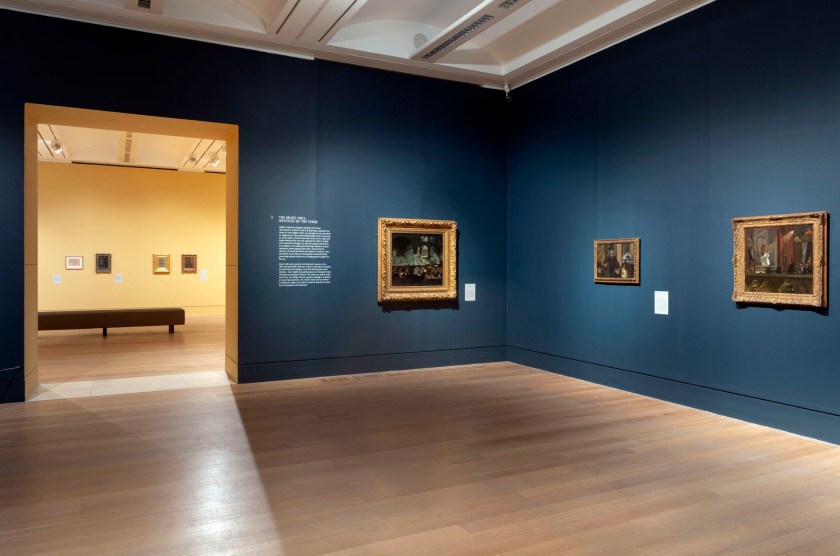
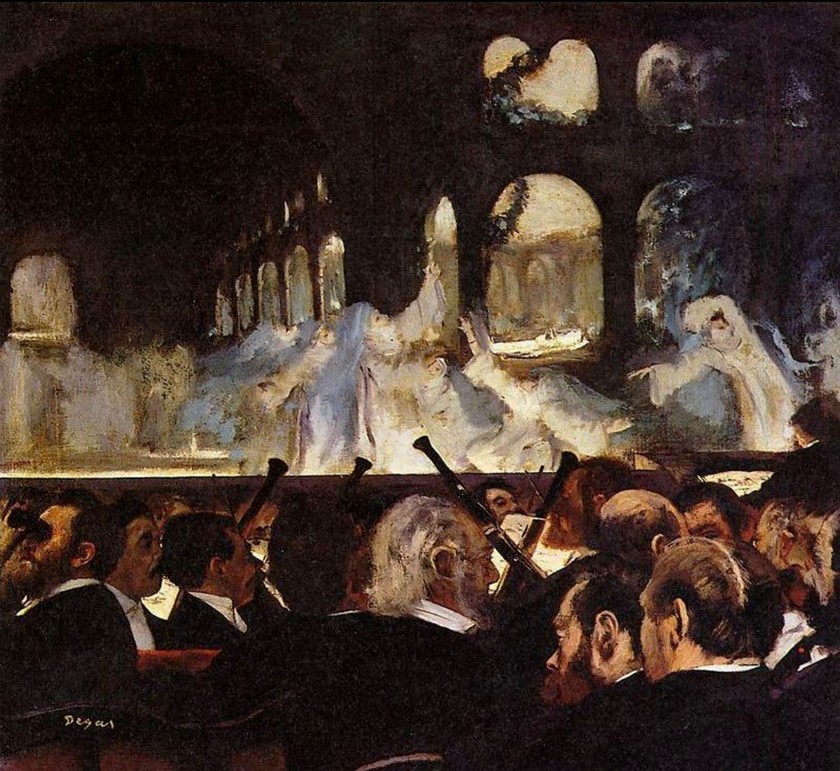
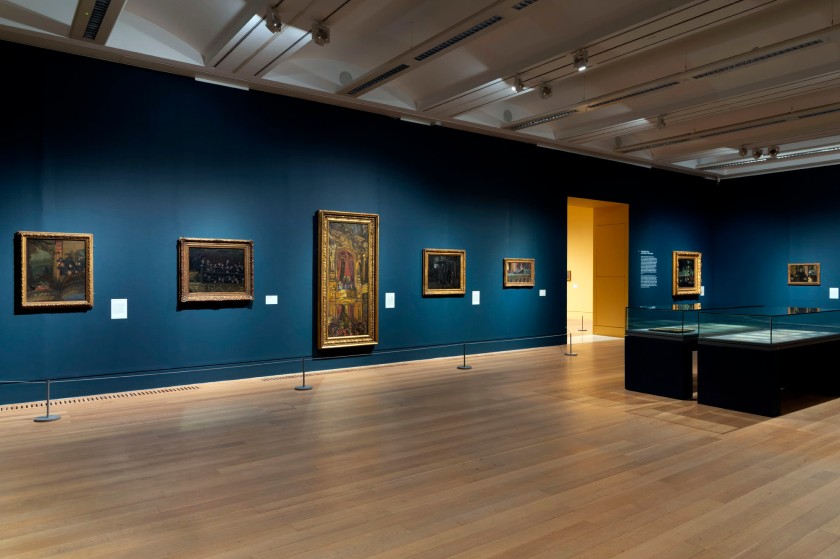

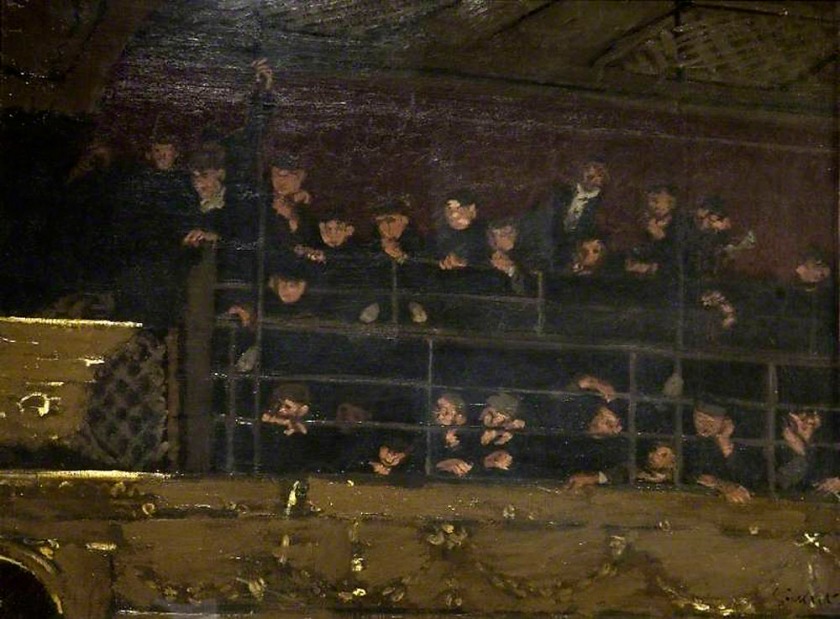




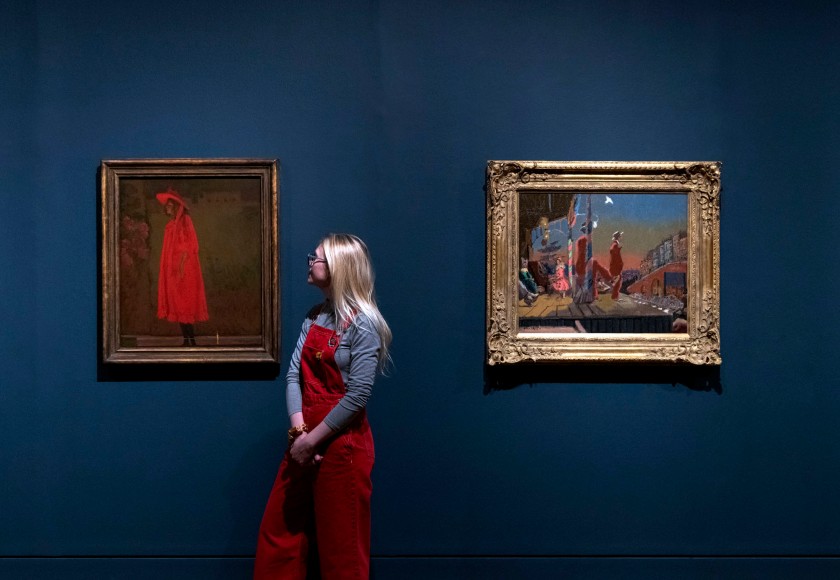






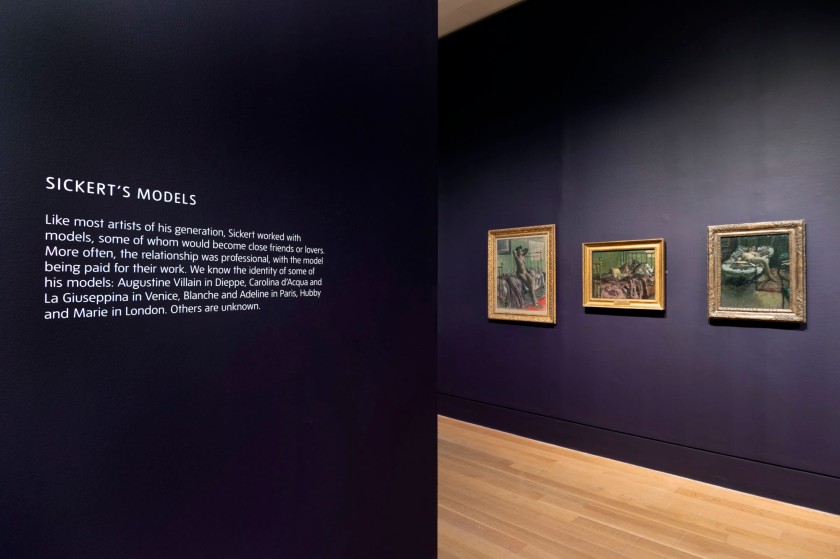




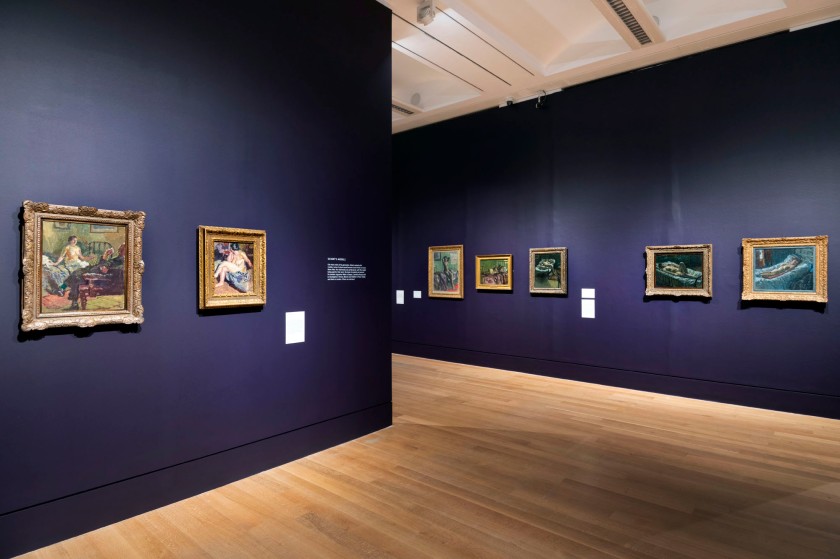








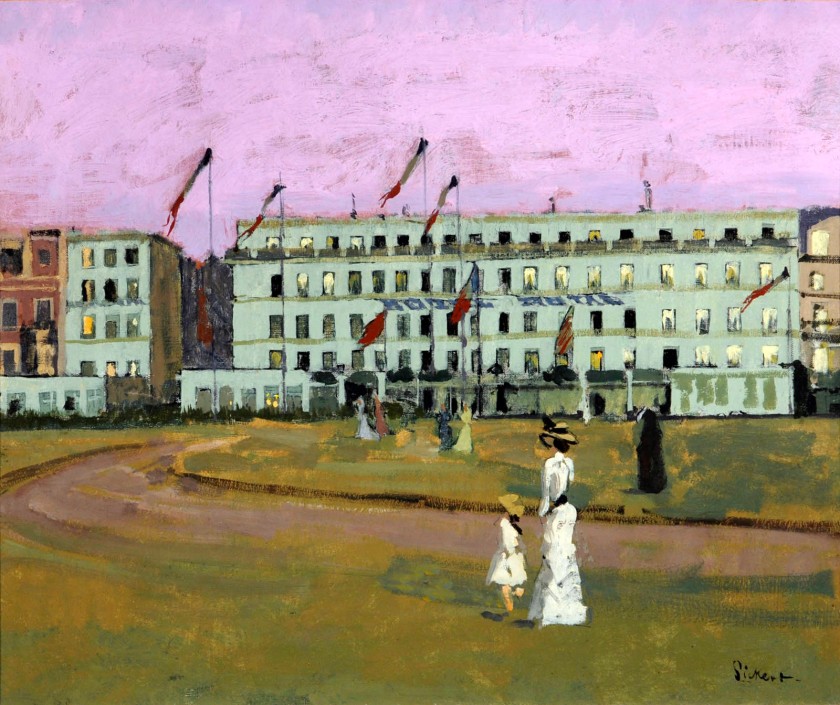
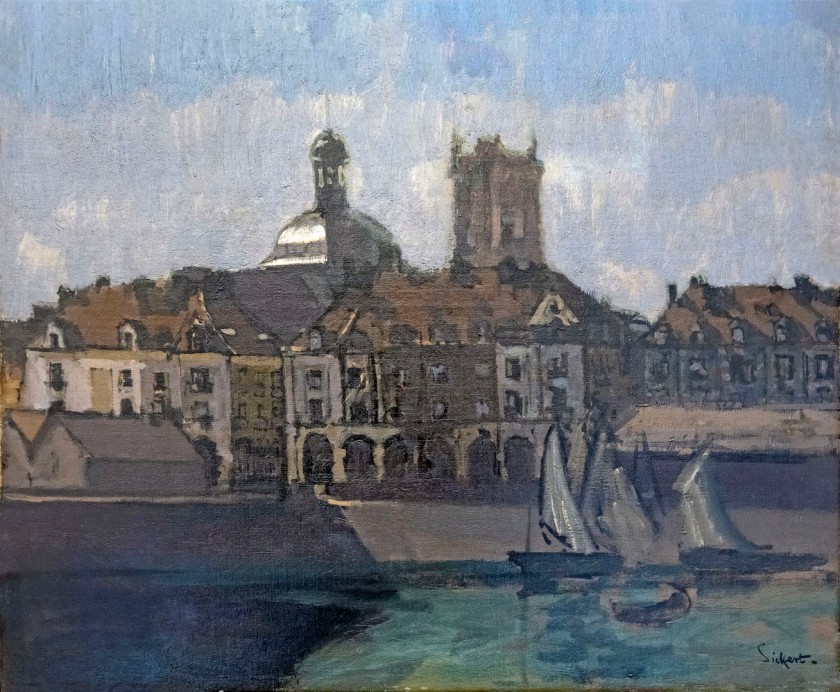











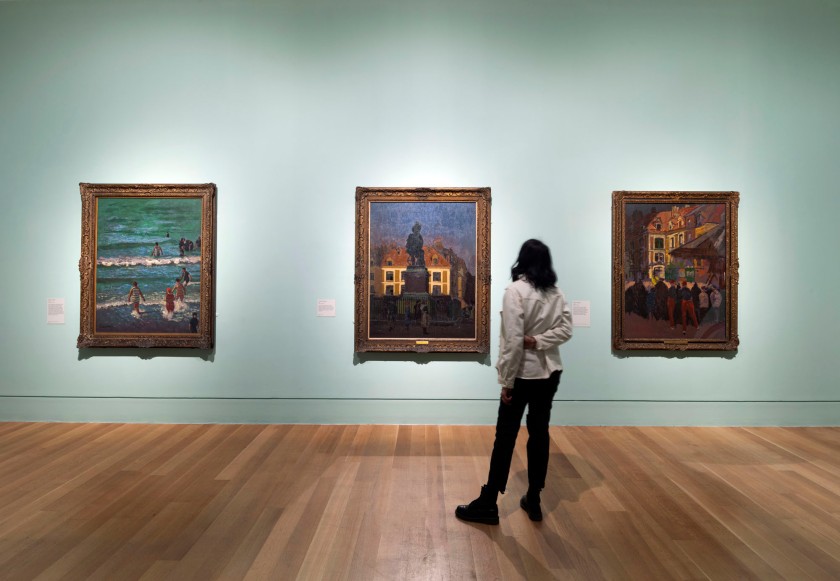




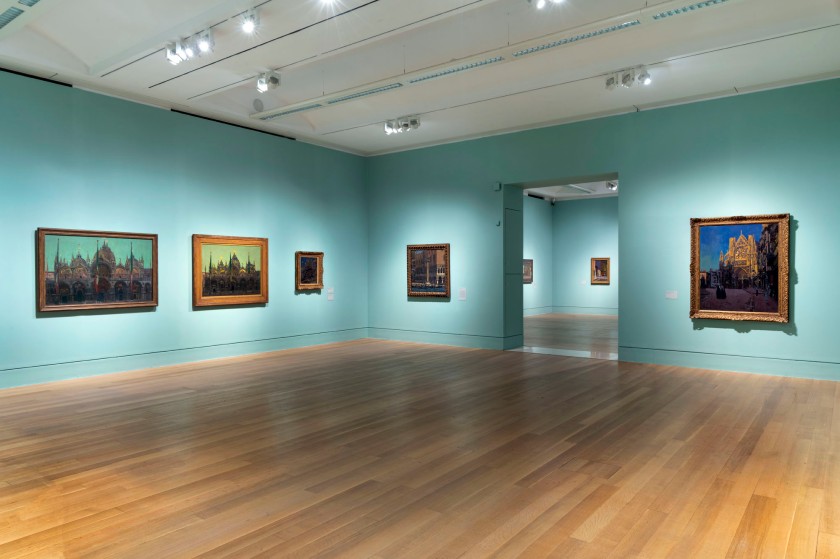


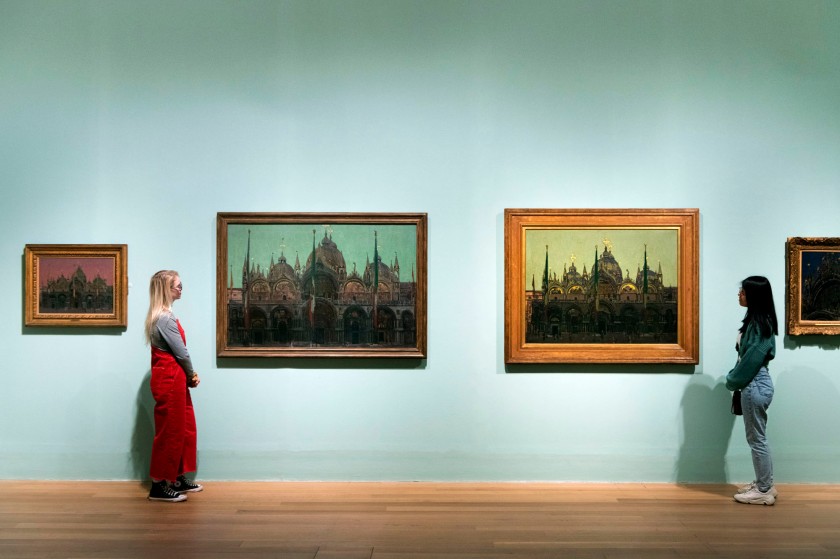





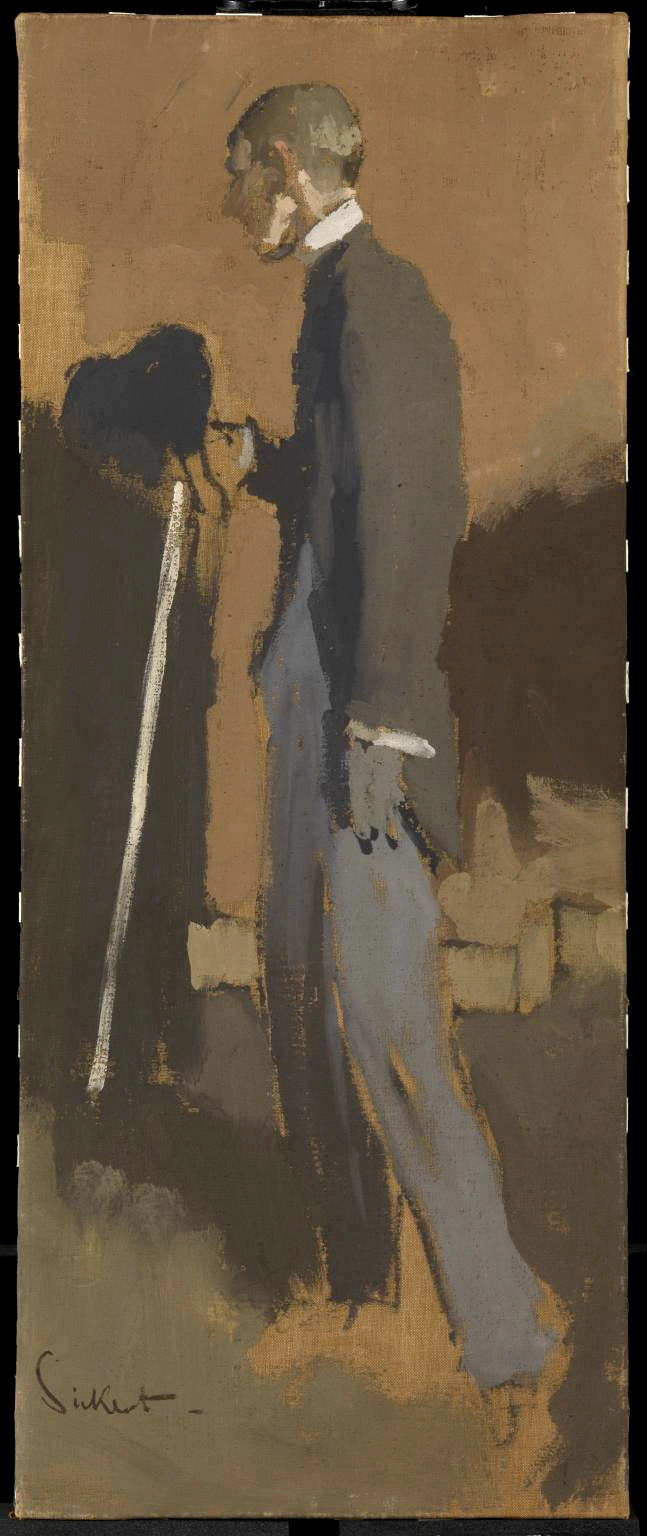




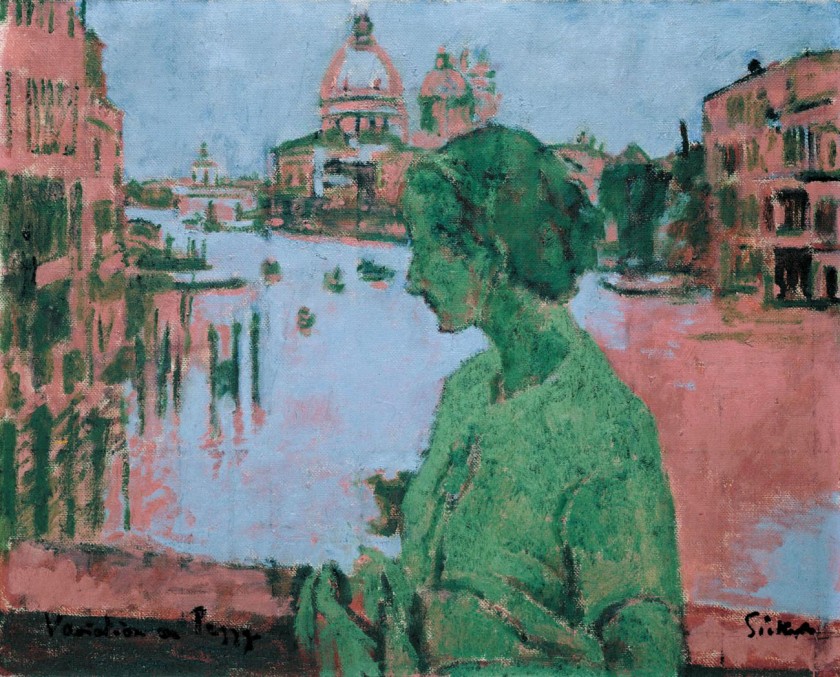

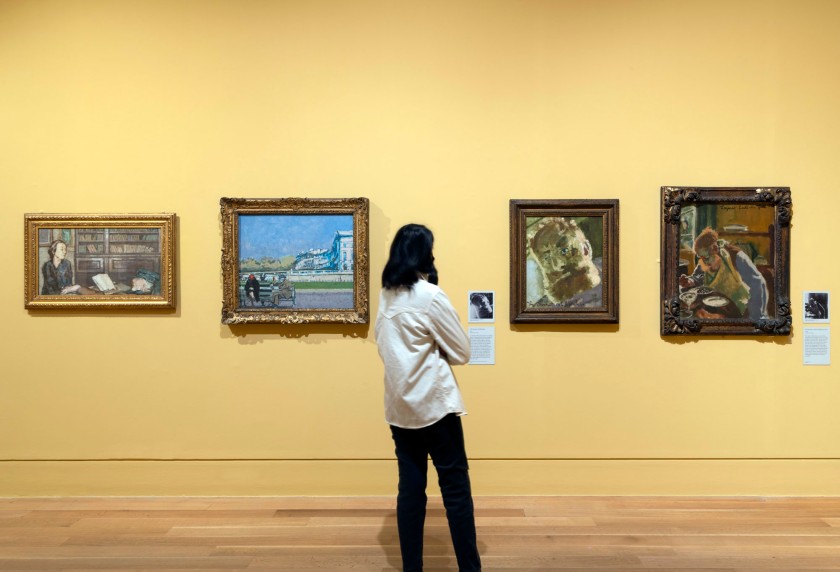











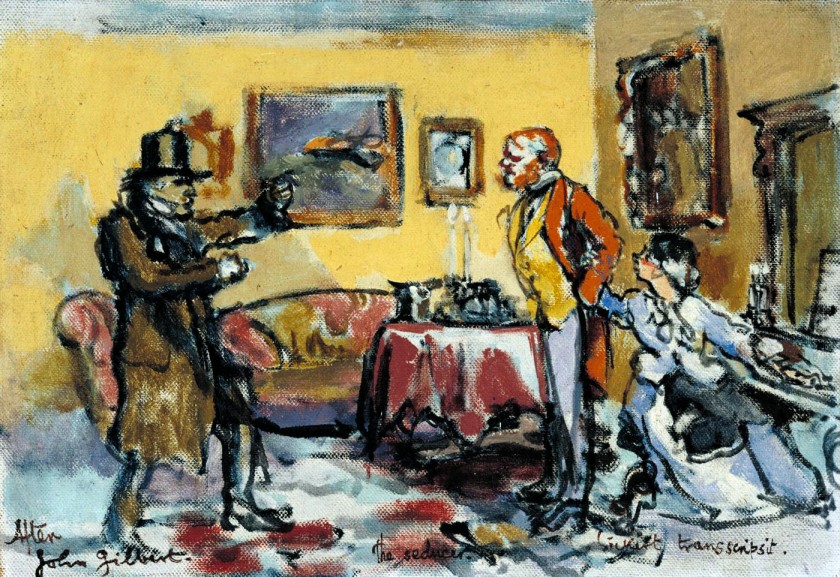

![Frederick Evans (British, 1853-1943) 'Aubrey Beardsley [with hands]' 1893 Frederick Evans (British, 1853-1943) 'Aubrey Beardsley [with hands]' 1893](https://artblart.com/wp-content/uploads/2020/04/frederick-evans-portrait-of-aubrey-beardsley.jpg?w=650&h=905)











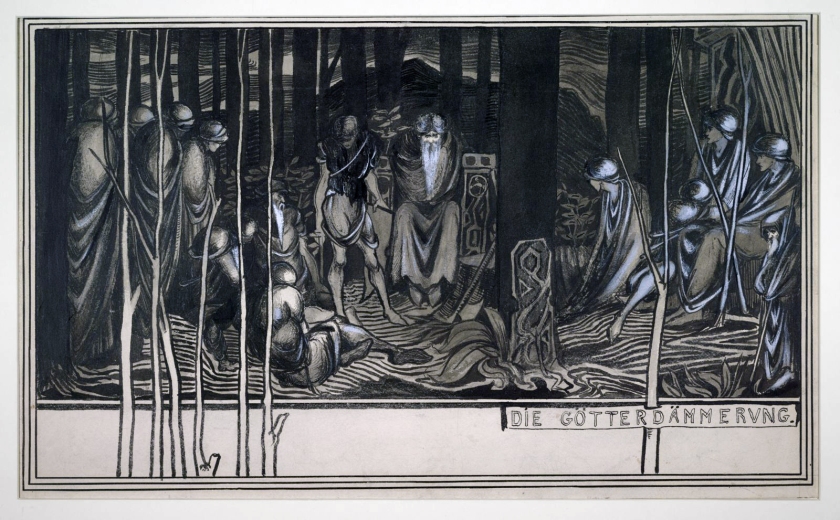
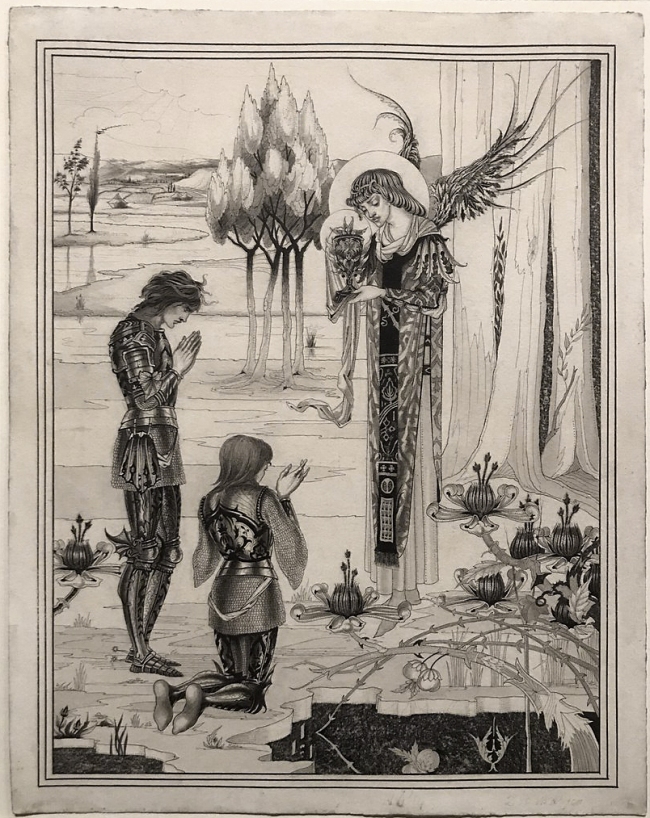






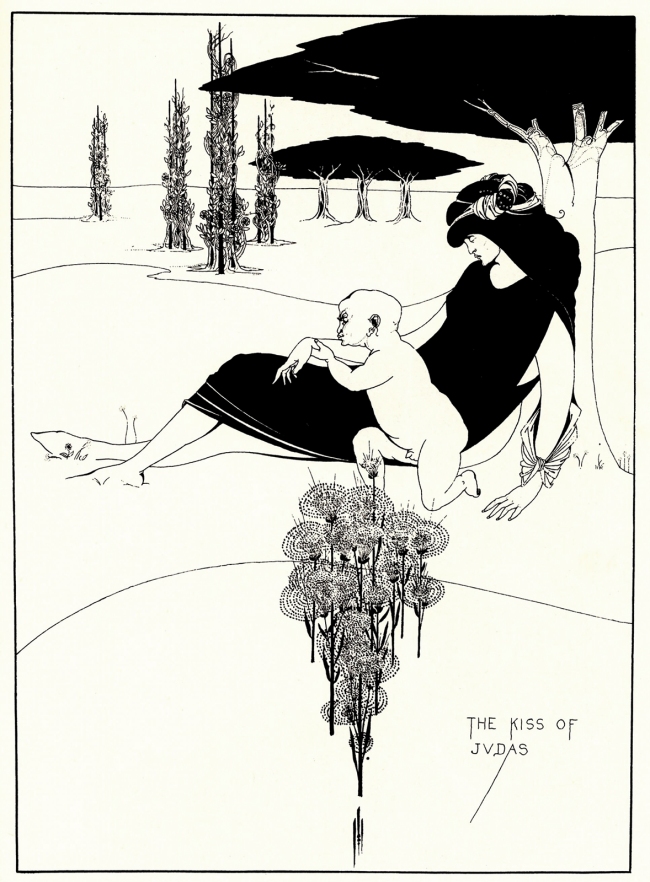



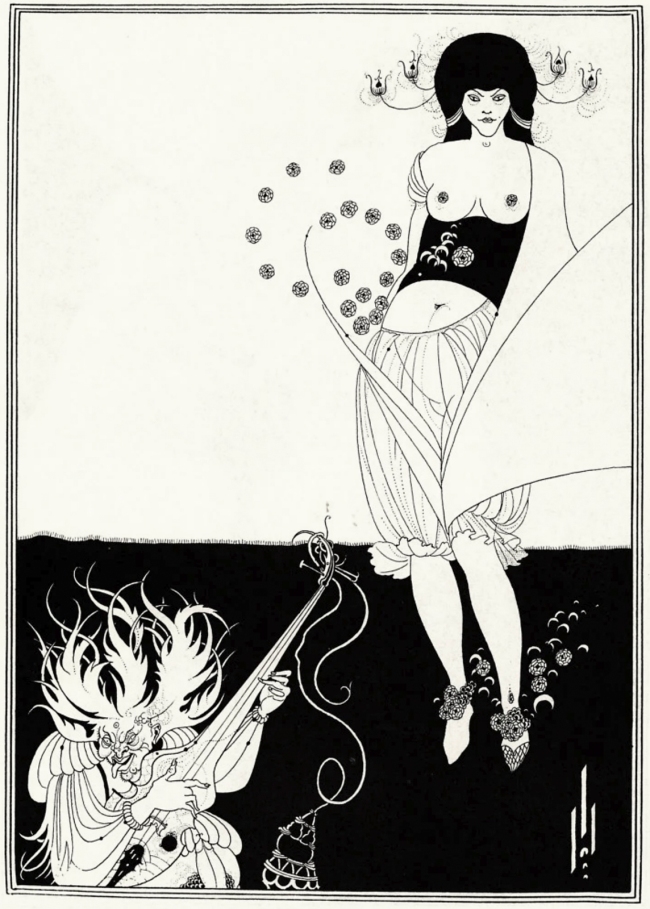




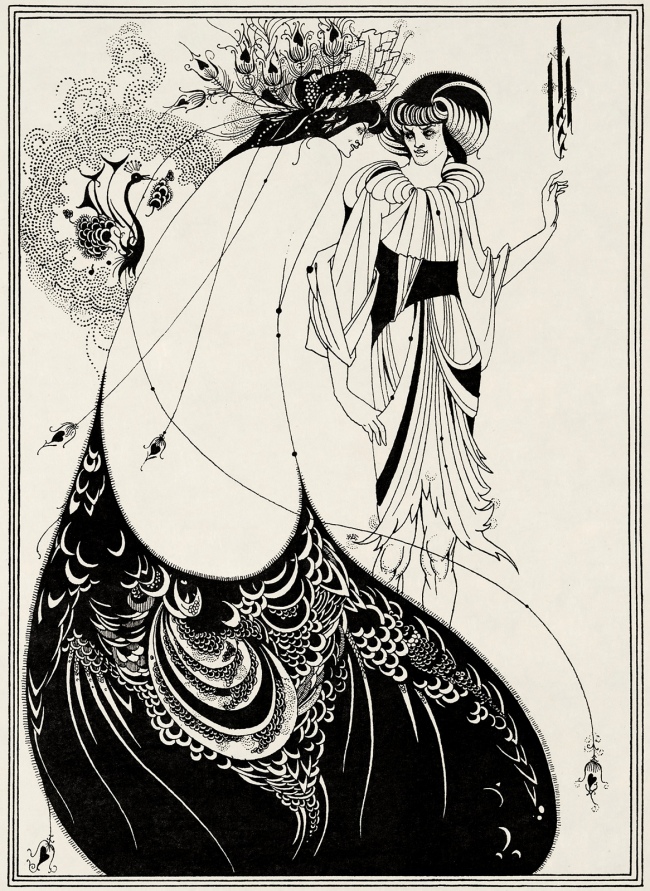










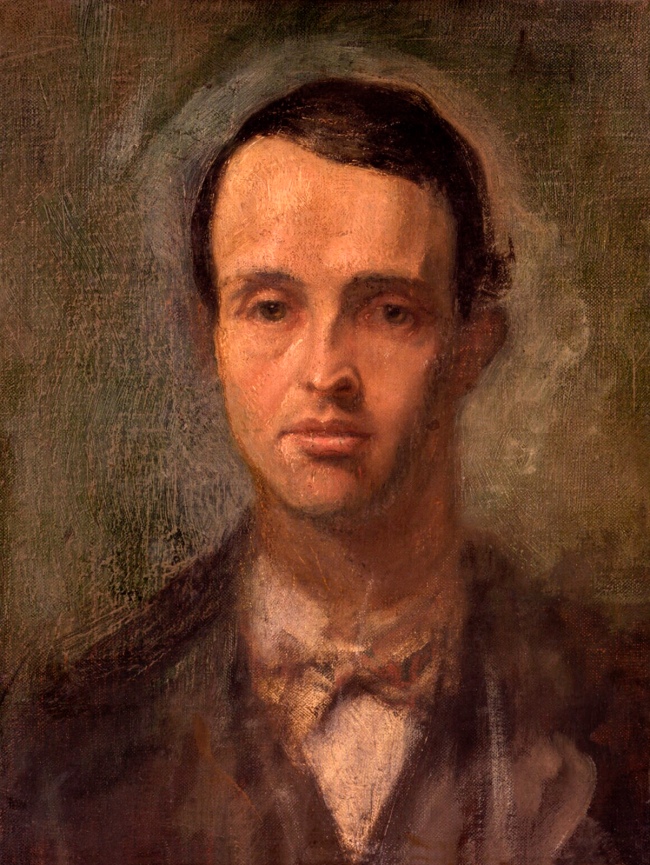








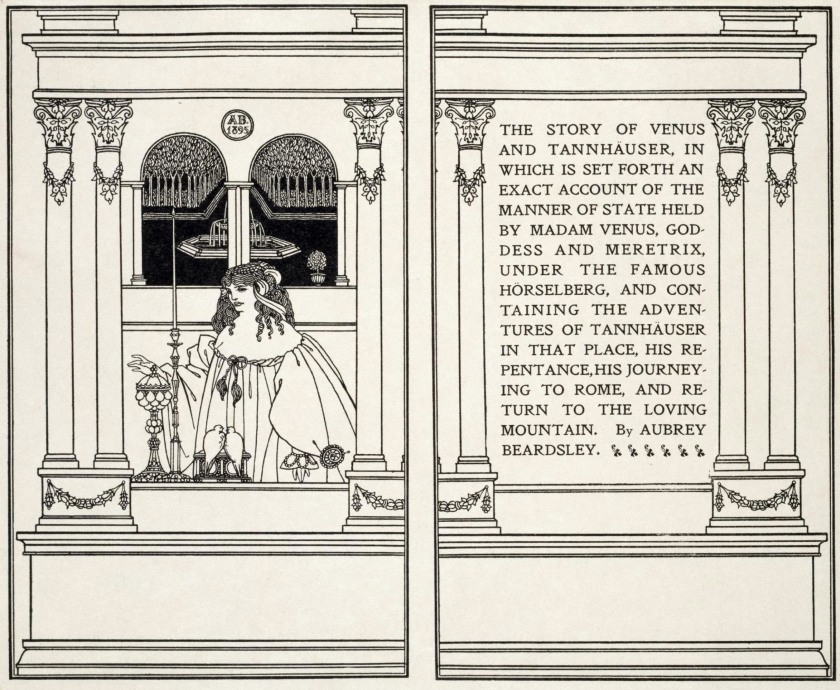

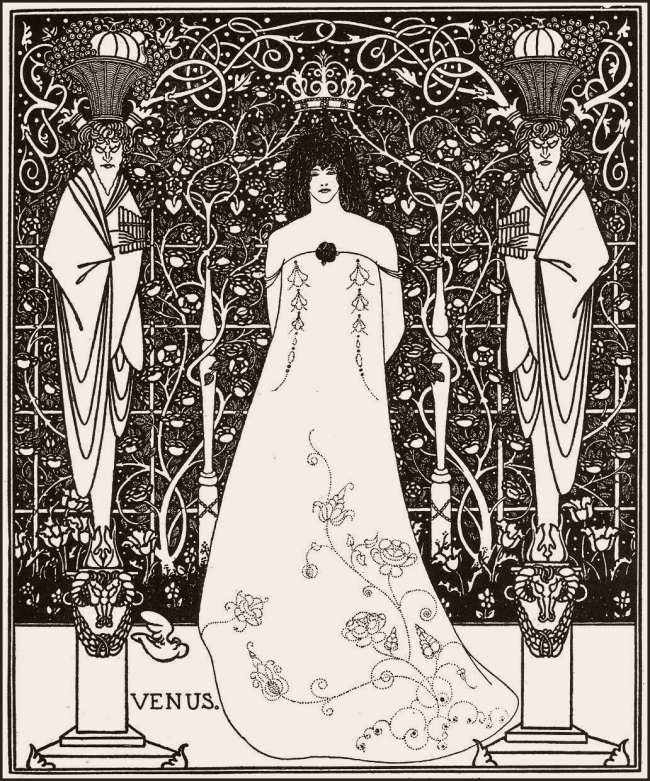


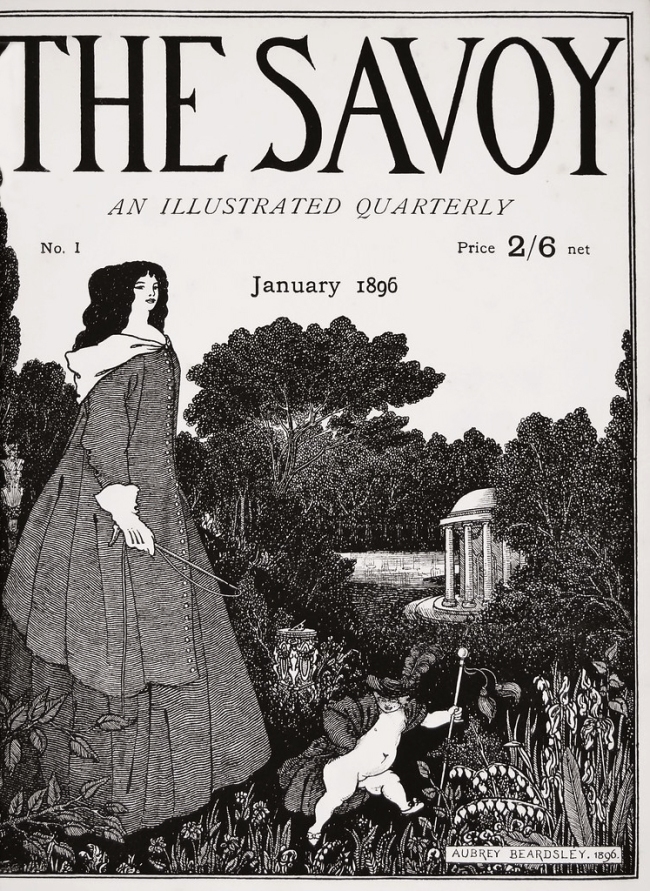












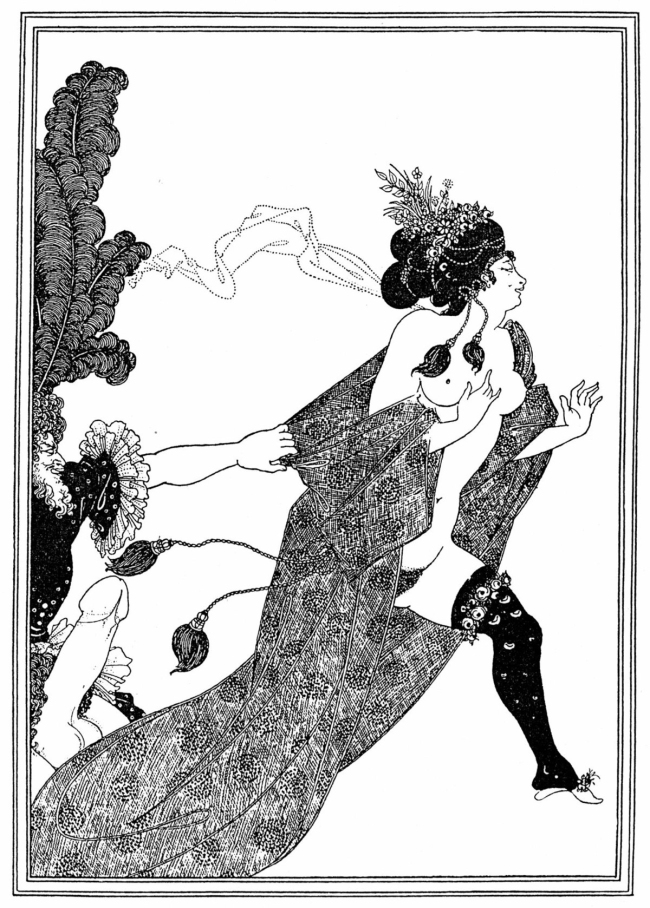







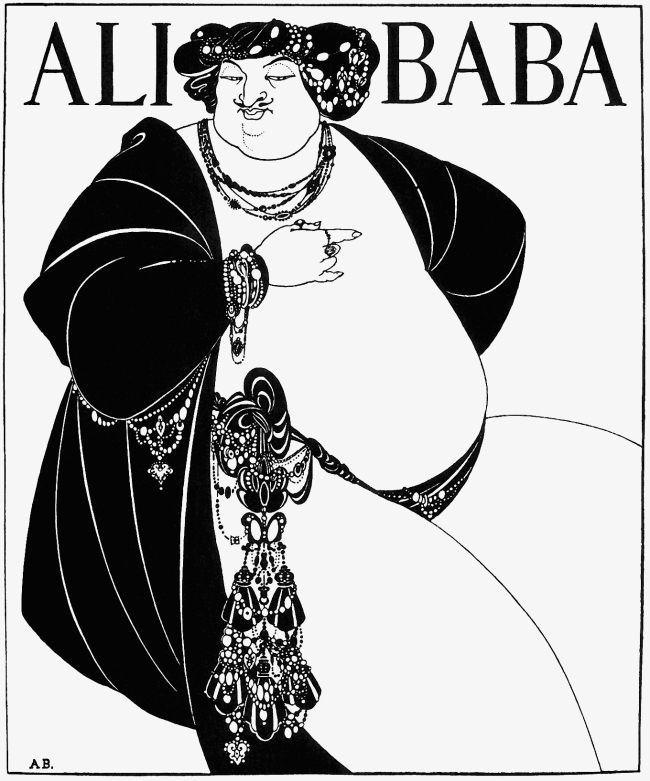
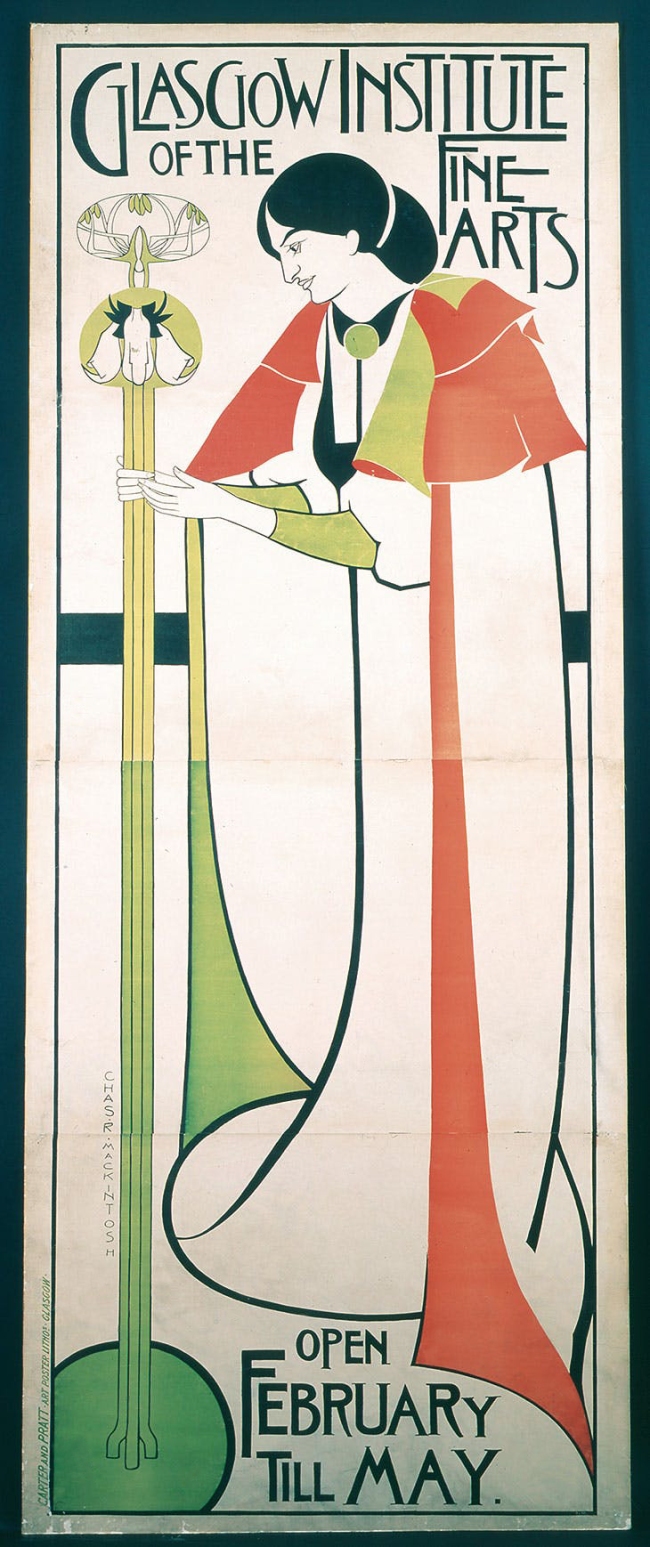

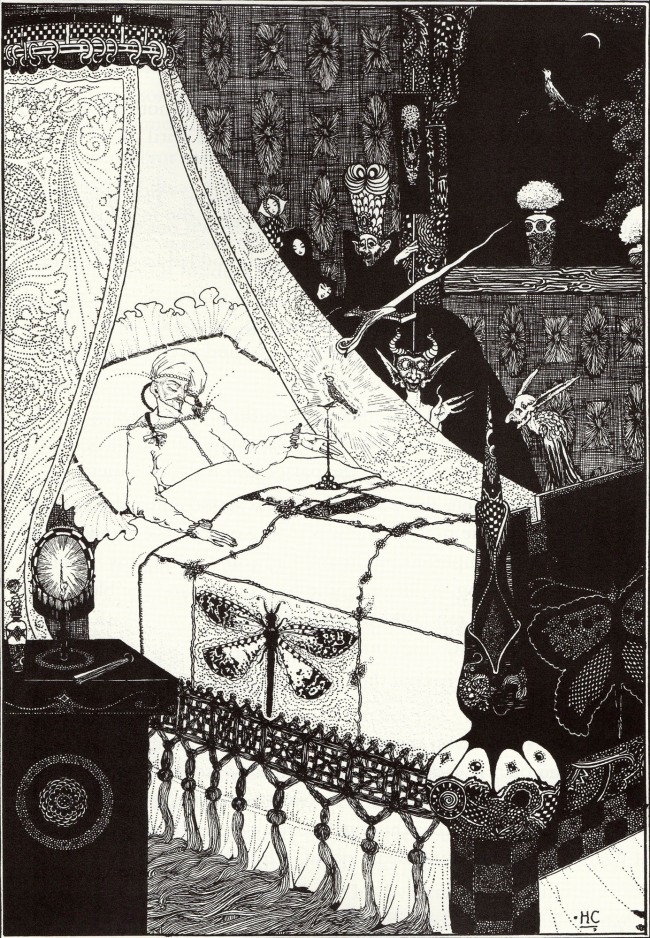

You must be logged in to post a comment.